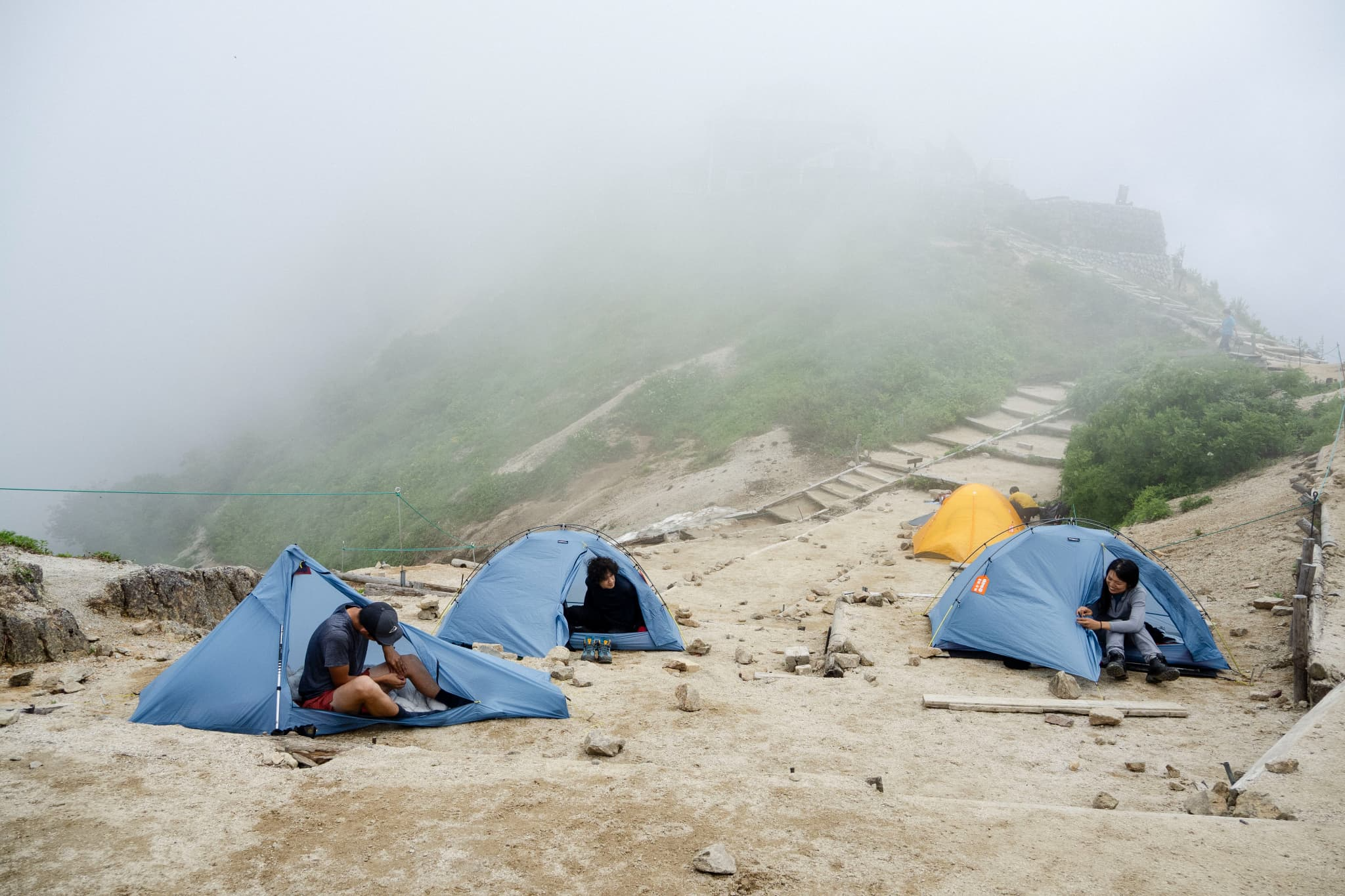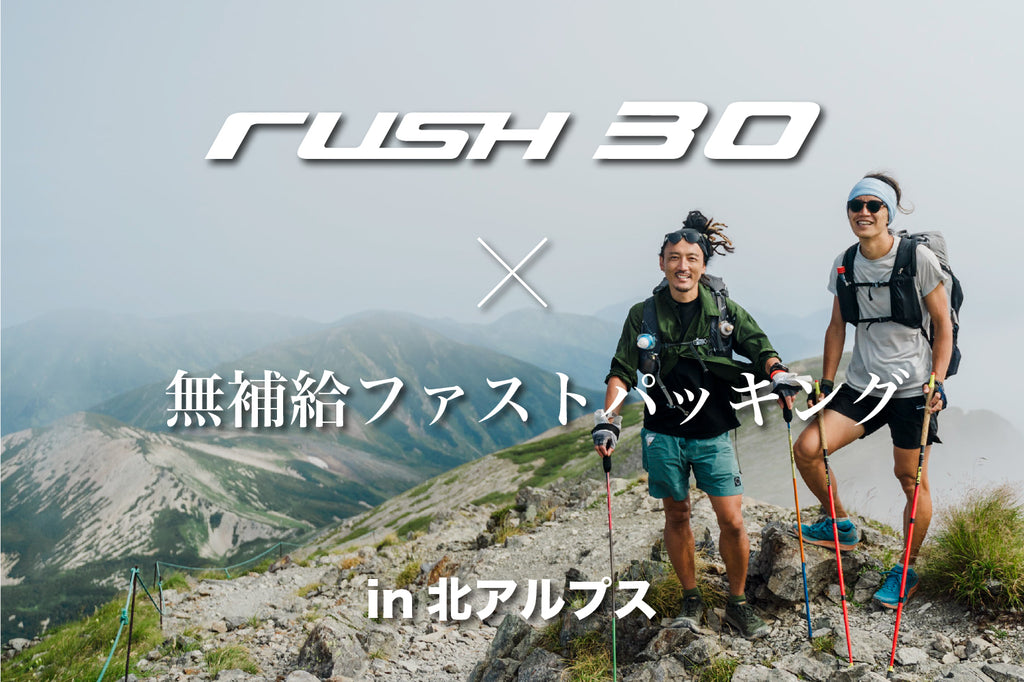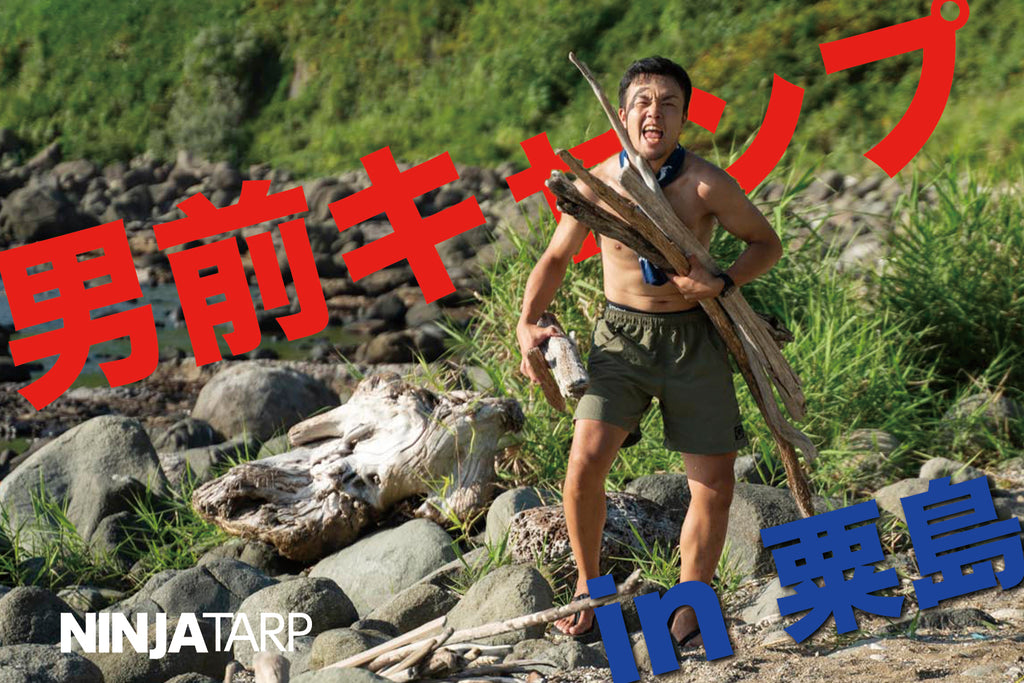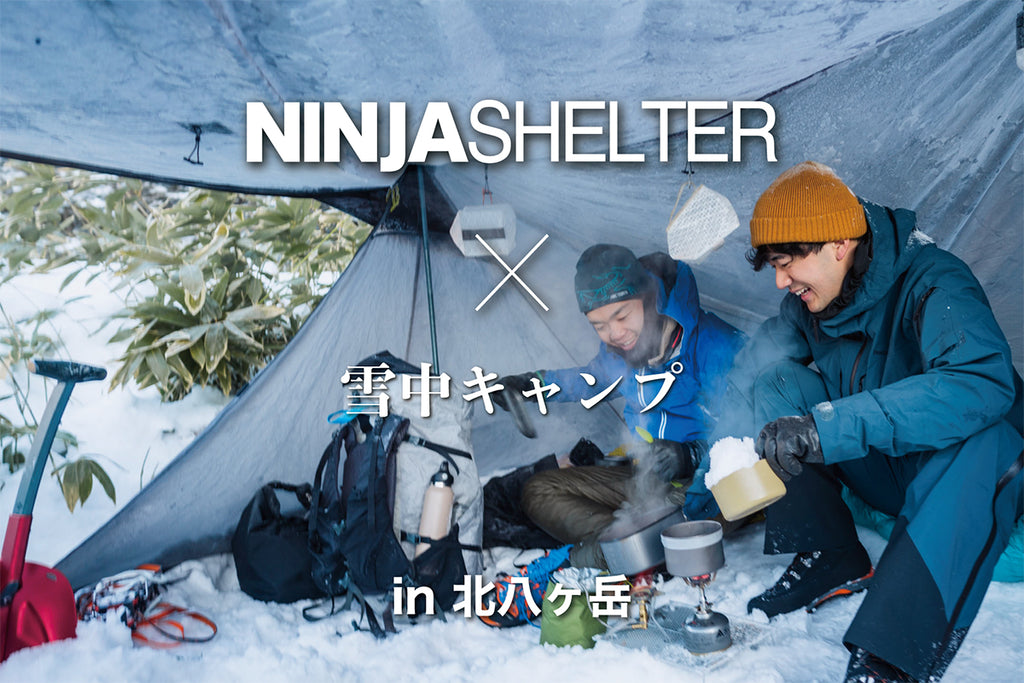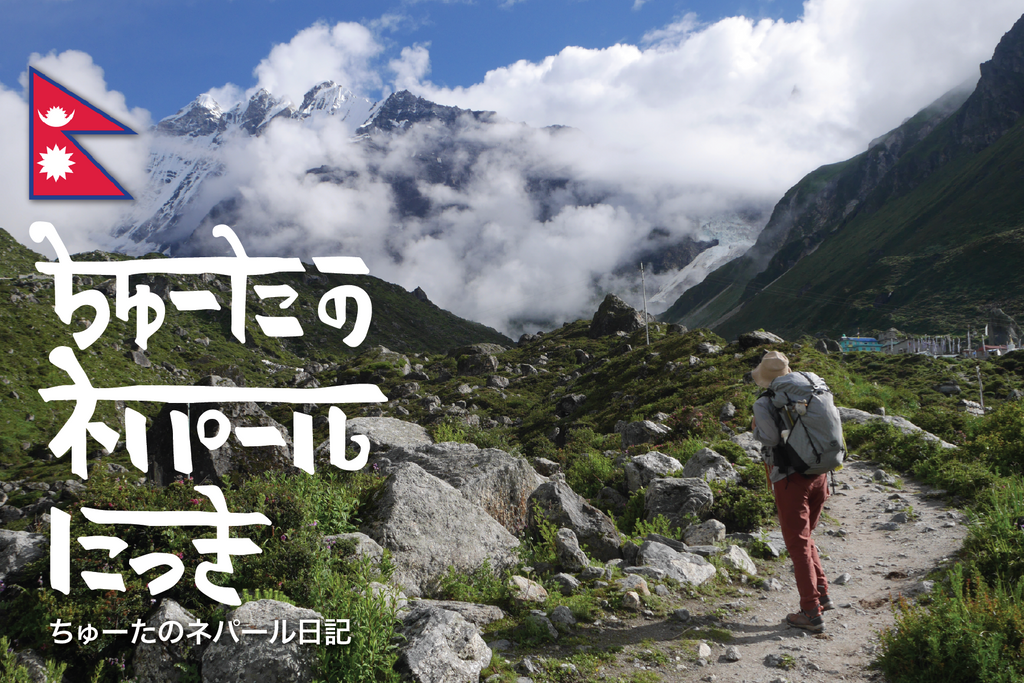MAGAZINE

ZENN × Tent Trekking in the Northern Alps: Omote-Ginza Route (Part 1)
PAAGOWORKS has welcomed a new addition to its product lineup, “ZENN.” This new outdoor-gear series pursues the “optimal solution for Japan’s mountains,” focusing relentlessly on lightness, functionality, and comfort.
The first release is a backpack whose innovative design “reconstructs” the core functions and performance of mountain equipment—lightweight build, superb carrying comfort, and customization options to match any style of mountain travel.
The lineup also includes two shelters that remain ultralight yet allow you to “sleep soundly in the mountains.”
-
ZENN DOME SHELTER – a lightweight free-standing tent, and
-
ZENN 2 POLE SHELTER – an even lighter shelter for mountain races and minimalists who want to keep gear to an absolute minimum.
Every item is engineered specifically for Japan’s peaks. We assumed a wide range of terrain and rapidly changing weather, packing in practical features while insisting on weight savings that expand your range and reduce fatigue.
So where can you truly feel the essence of the ZENN series? We designed it for everything from technical alpine ridges to scenic long hikes, but decided that an alpine traverse—where you face all kinds of situations—is the ultimate test. That’s why the PAAGOWORKS staff headed for Omote-Ginza, one of the Northern Alps’ classic routes. Over three days and two nights we’ll show you what ZENN can do.
And, as always, our trip was full of the classic PAAGO mishaps. Enjoy our big adventure on one of the Alps’ most popular routes!
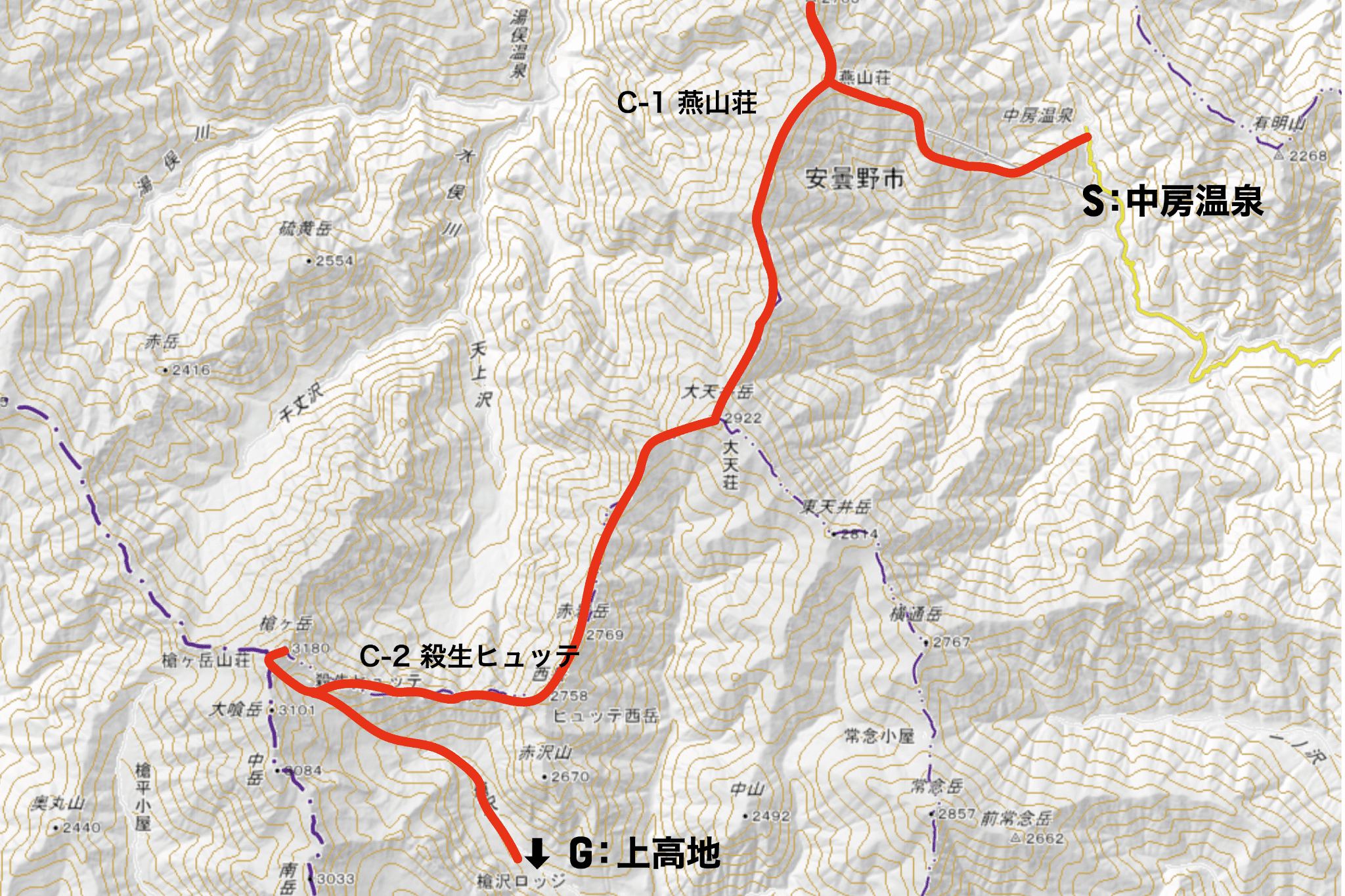
About the Route
Omote-Ginza begins at Nakabusa Onsen, traverses Mt. Tsubakuro and Mt. Ōtenjō, then climbs Mt. Nishi via the Higashi-Kama ridge to the summit of Mt. Yari. From Yari, the usual finish is to descend the Yarisawa valley to Kamikochi.
-
Total distance: ~40 km
-
Cumulative ascent: ~3,200 m
-
Recommended for strong hikers
Although it takes three days and two nights, the route offers sweeping 3,000-meter vistas and deep trails unreachable on a day trip.
This time we stayed the night before in a hotel in Matsumoto City, took the first morning bus from Hotaka Station to Nakabusa Onsen, camped at the Tsubakuro campsite near Enzansō hut, then on Day 2 traversed Mt. Ōtenjō and Mt. Nishi to Sessei Hütte. On the final morning we climbed Mt. Yari at dawn, packed up, descended in one push to Kamikochi, and took the bus back to Hotaka Station.
DAY 1 — To Mt. Tsubakuro, Gateway to Omote-Ginza
The journey begins at Nakabusa Onsen. Until recently you could drive to the trailhead, but because we used the shuttle around the collapsed section, we started just after 8 a.m.—a little late. Still, Day 1 was only a four-hour climb to Enzansō, so we took our time and let our bodies acclimate.
The Crew
-
Knorr (center) – an all-rounder who enjoys everything from traverses to ski mountaineering
-
Ume (right) – trail-runner with 100-mile race experience
-
Shohoko (left) – backpacker who favors a classic, not-so-ultralight style
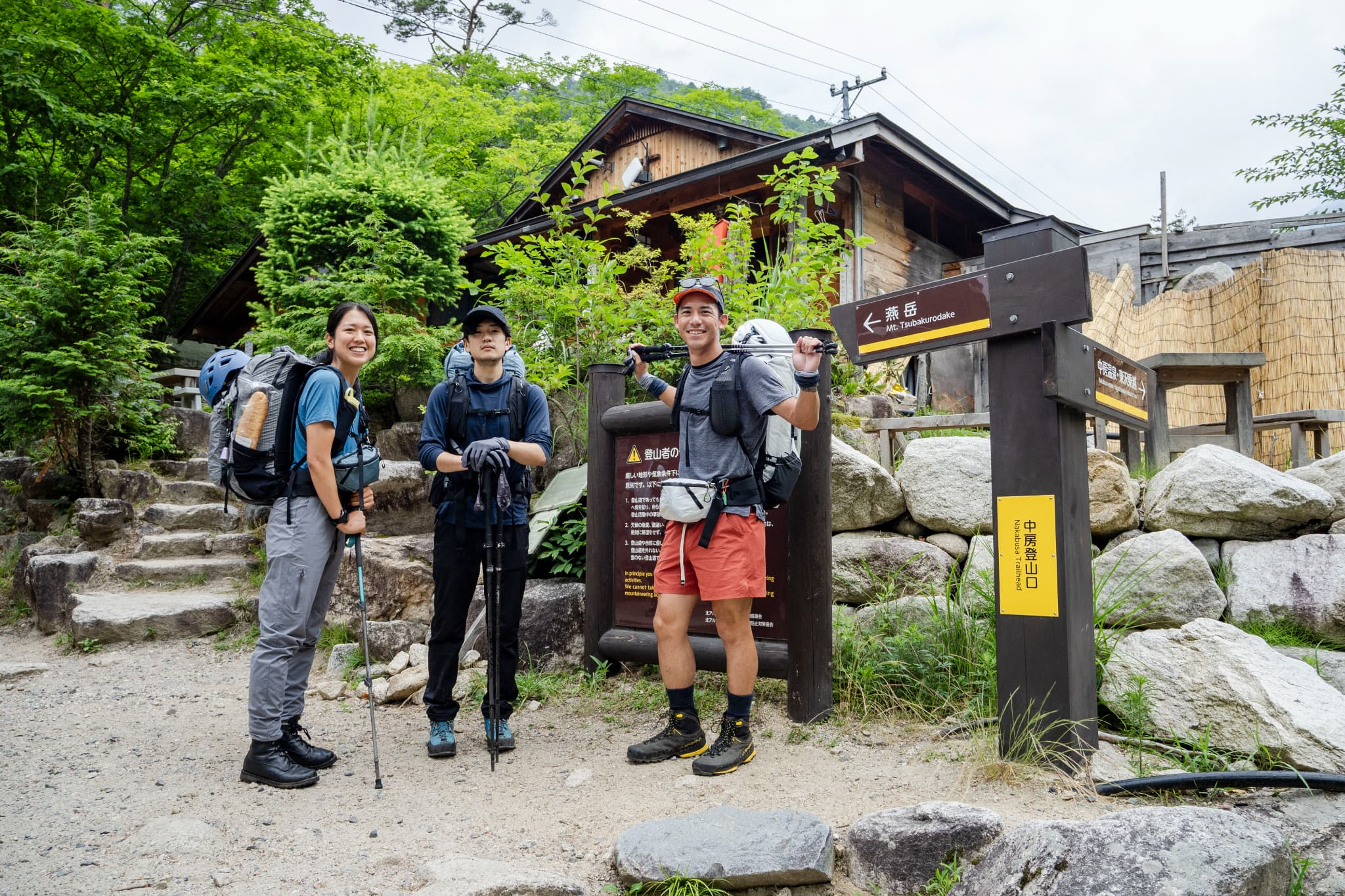
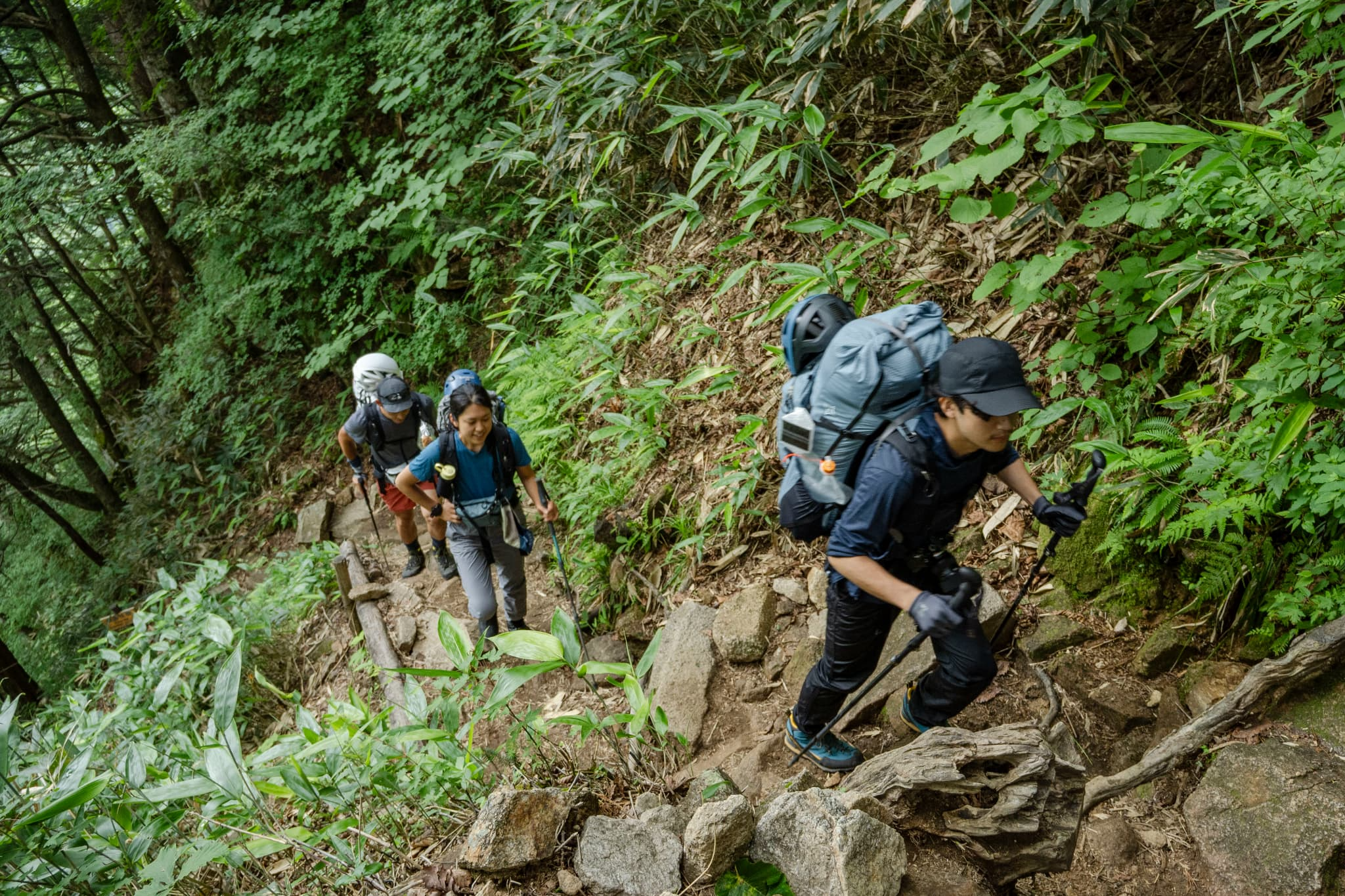
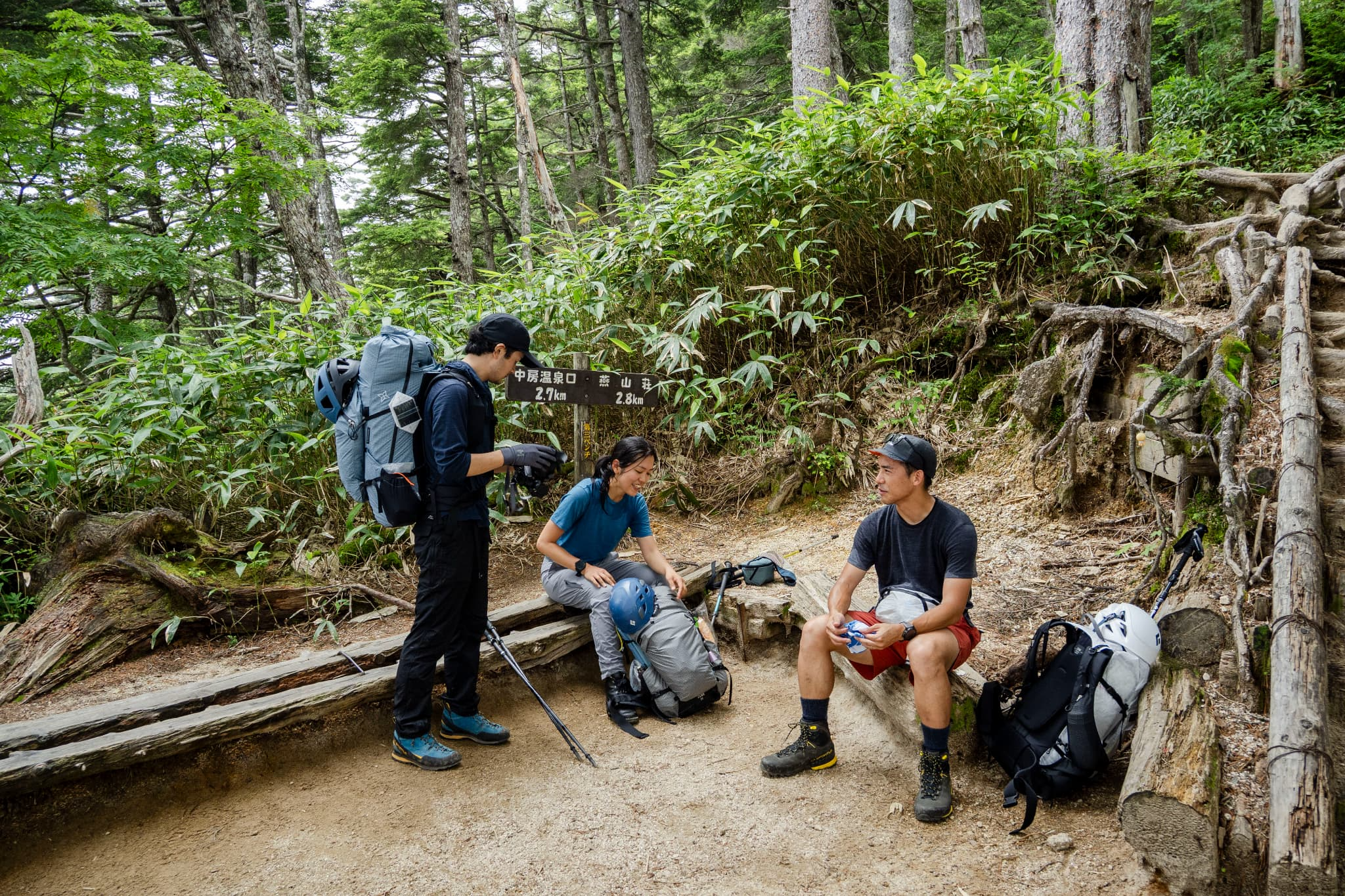
The Kassen Ridge climb
Kassen Ridge is counted among the Northern Alps’ “three great steep climbs,” gaining 1,250 m to Enzansō. On day one our packs were heavy with food. The forest was muggy and we were soon out of breath. We gratefully rested at each bench along the way—but this was just the prologue. No burning out here!
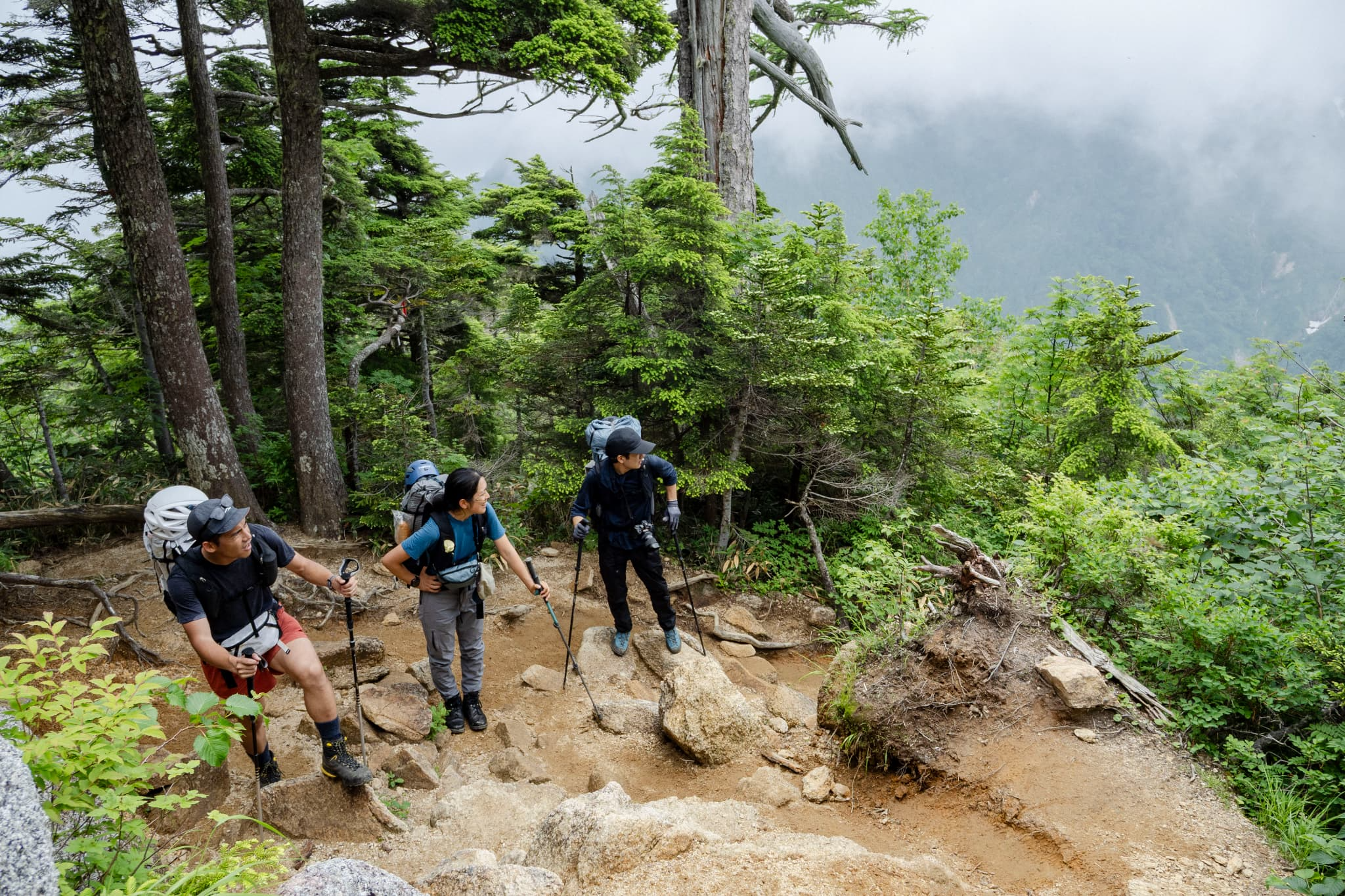
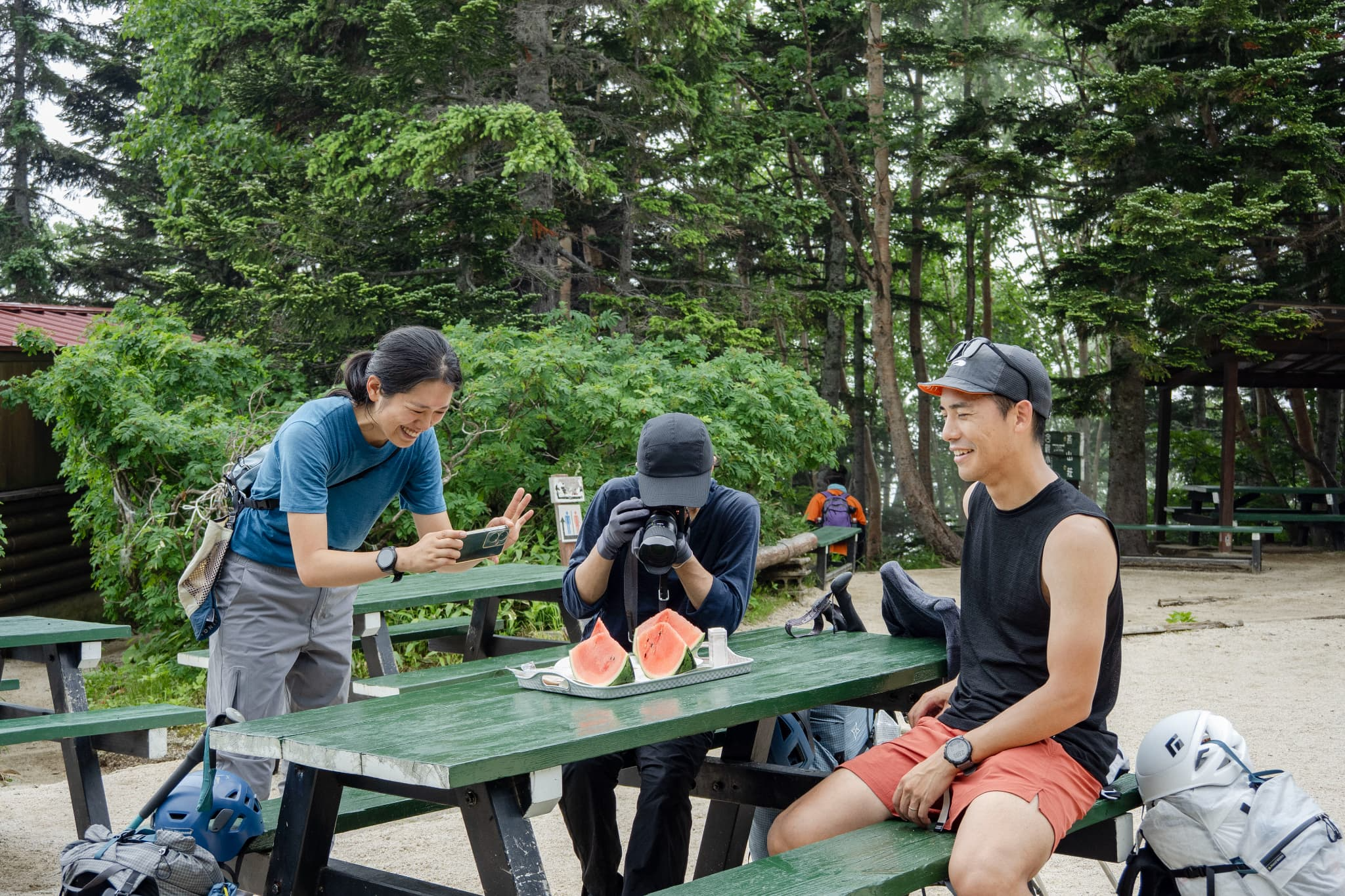
Ume’s Voice
By the time we reached Kassen-goya (the halfway hut), my merino tee had changed color with sweat. The prize here is watermelon! I wondered how they serve watermelon on a mountain, but then saw the cargo ropeway.
The first bite was heaven—juicy sweetness instantly washed away my fatigue. A sprinkle of salt made it even better. I must have said “I want more watermelon” a dozen times after we left.
As a trail-runner I rarely carry a full camping load; packing was tough, but I kept it to ~10 kg. Even so, carrying that weight was new to me. The ZENN pack fit perfectly and felt stress-free. Moving slowly, admiring flowers and distant peaks, I felt excited about what views lay ahead.
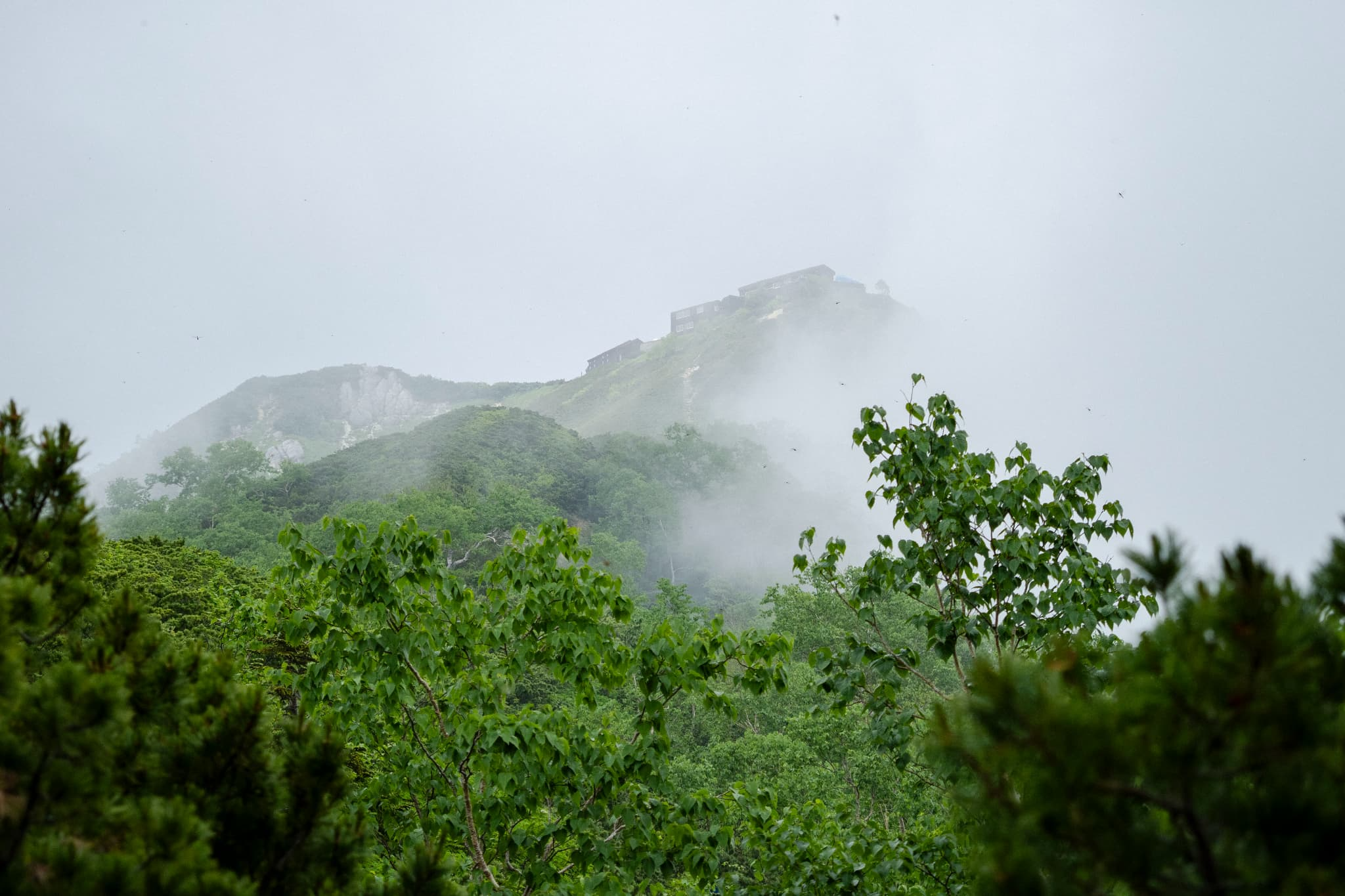
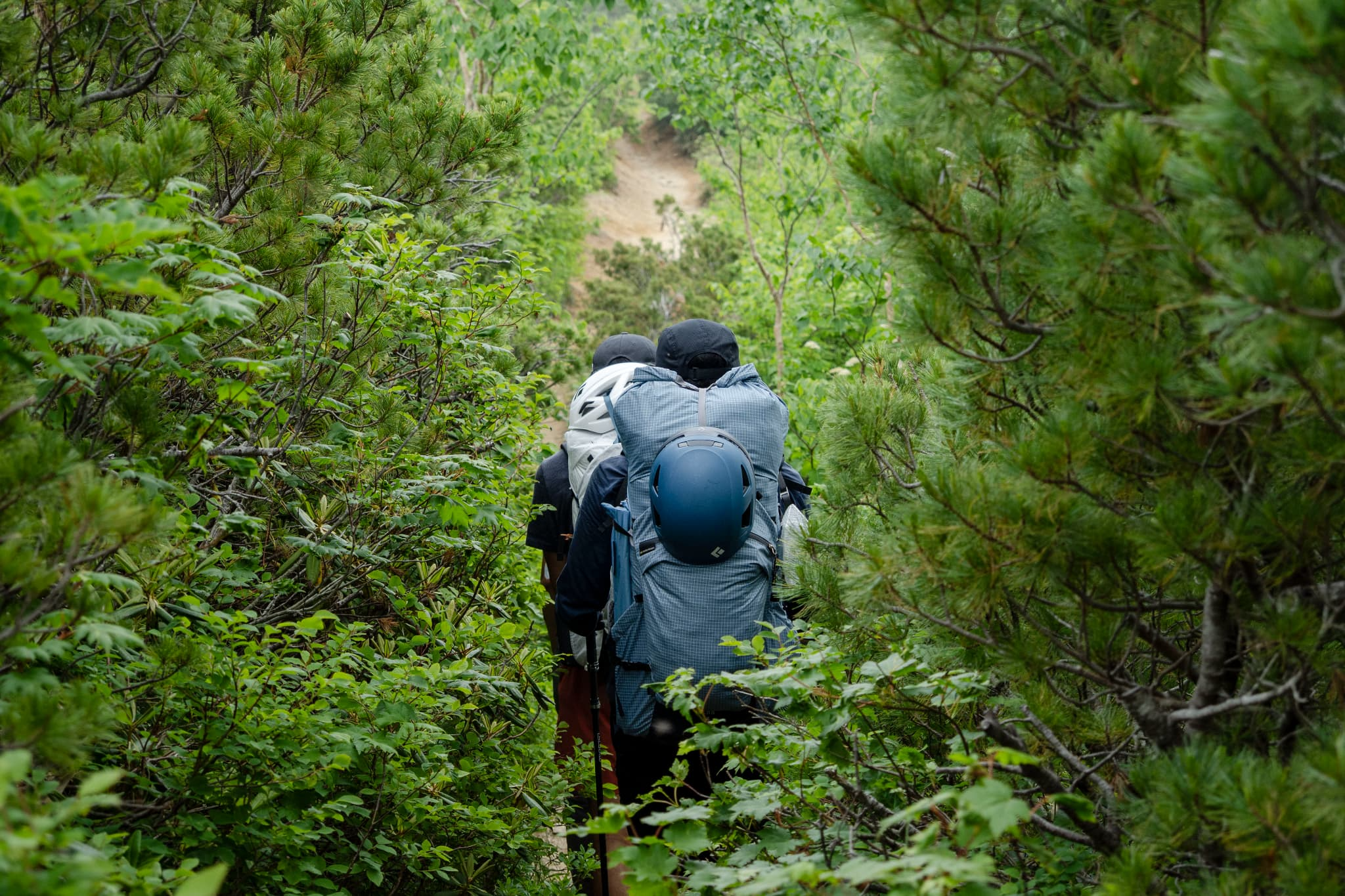
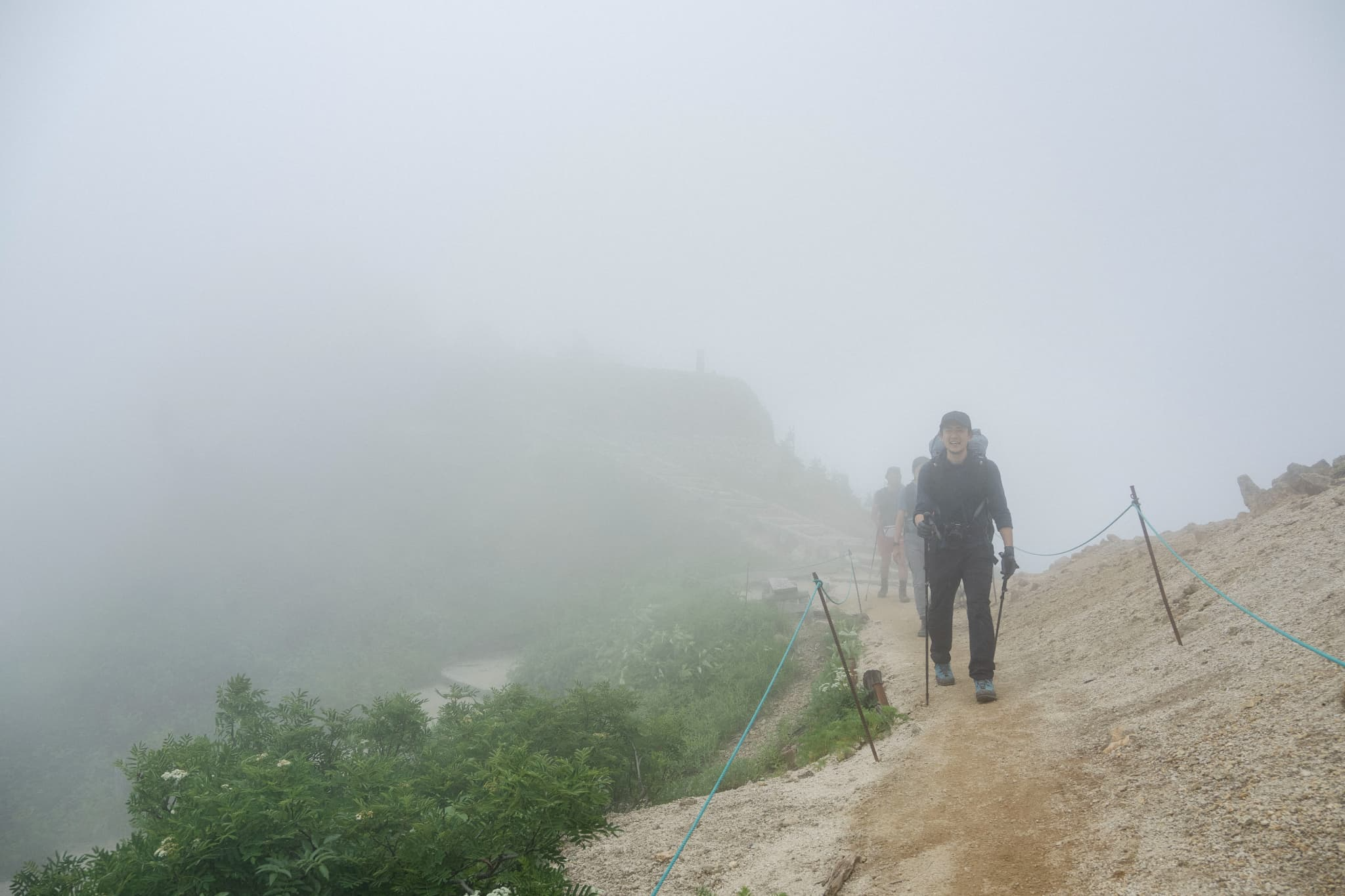
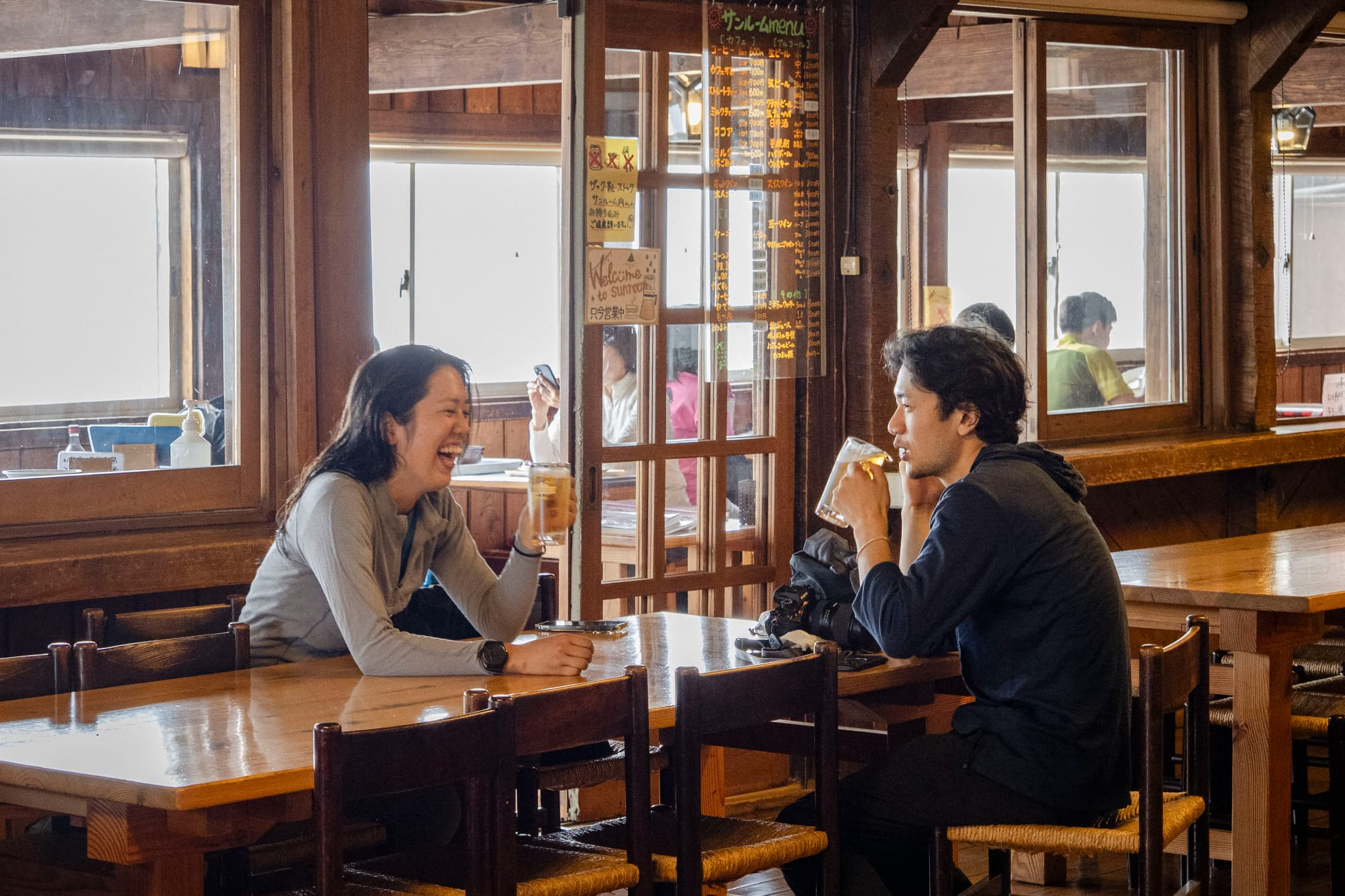
Shohoko’s Voice
Steep Kassen Ridge, one of the Alps’ big three climbs—hot, humid, and heavy packs meant a slow ascent. But chatting with other ZENN users and the crew made the time fly, and we reached Enzansō in no time. Beer after a sweaty climb? Heaven!
We chose to camp, but Omote-Ginza has huts at key points, so it’s safe. ZENN 25 is the perfect size for hut trips too, so anyone nervous about camping can link huts and roam light.
Camp setup & a side trip to Mt. Tsubakuro
We reached the Enzansō campsite just after noon. After registering, we pitched two new ZENN shelters:
-
ZENN DOME SHELTER – cross-frame, free-standing, storm-worthy, yet just 895 g minimum weight.
-
ZENN 2 POLE SHELTER – uses trekking poles, packs tiny, only 410 g.
We’ll report how they performed in real conditions.
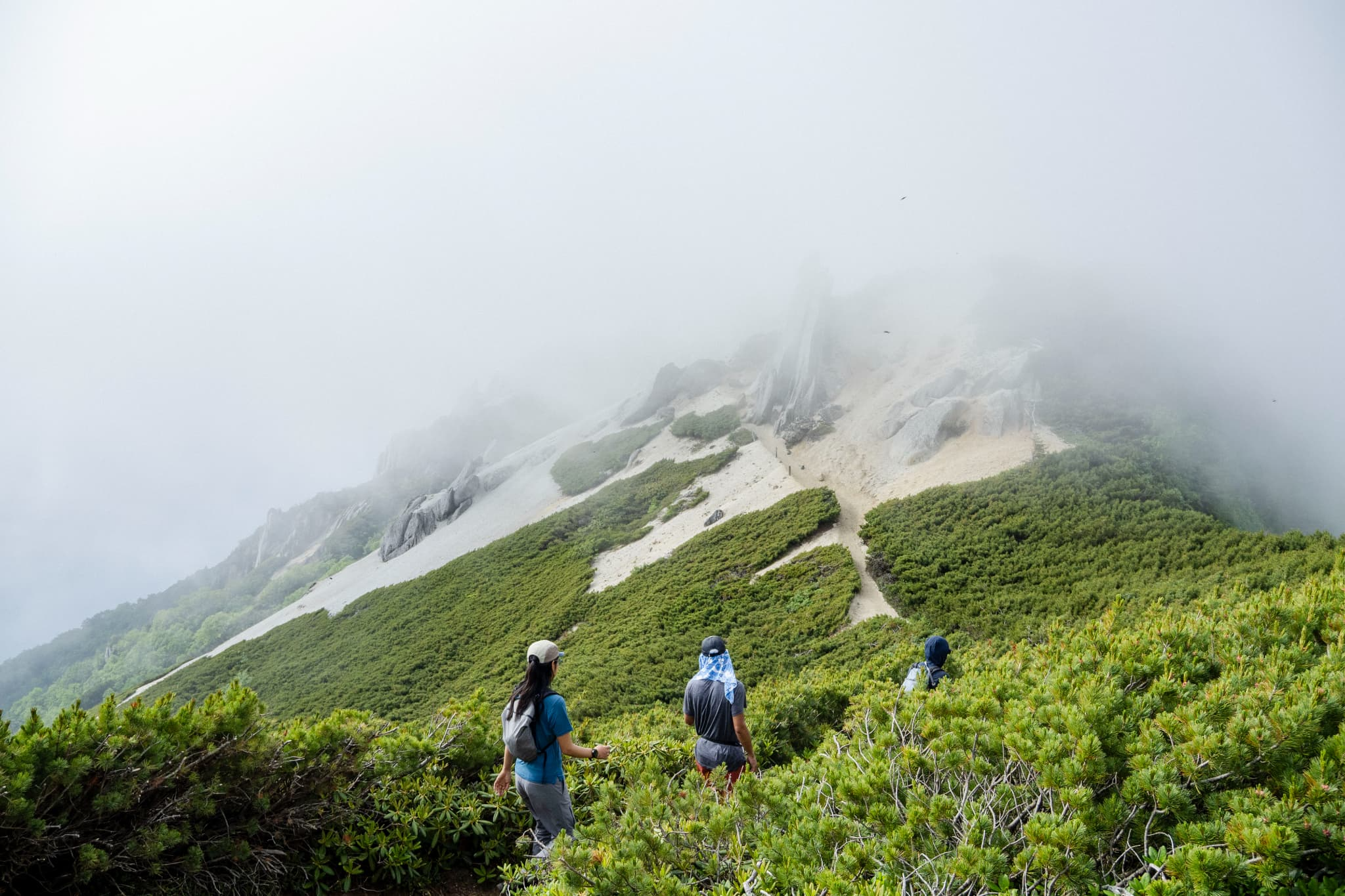
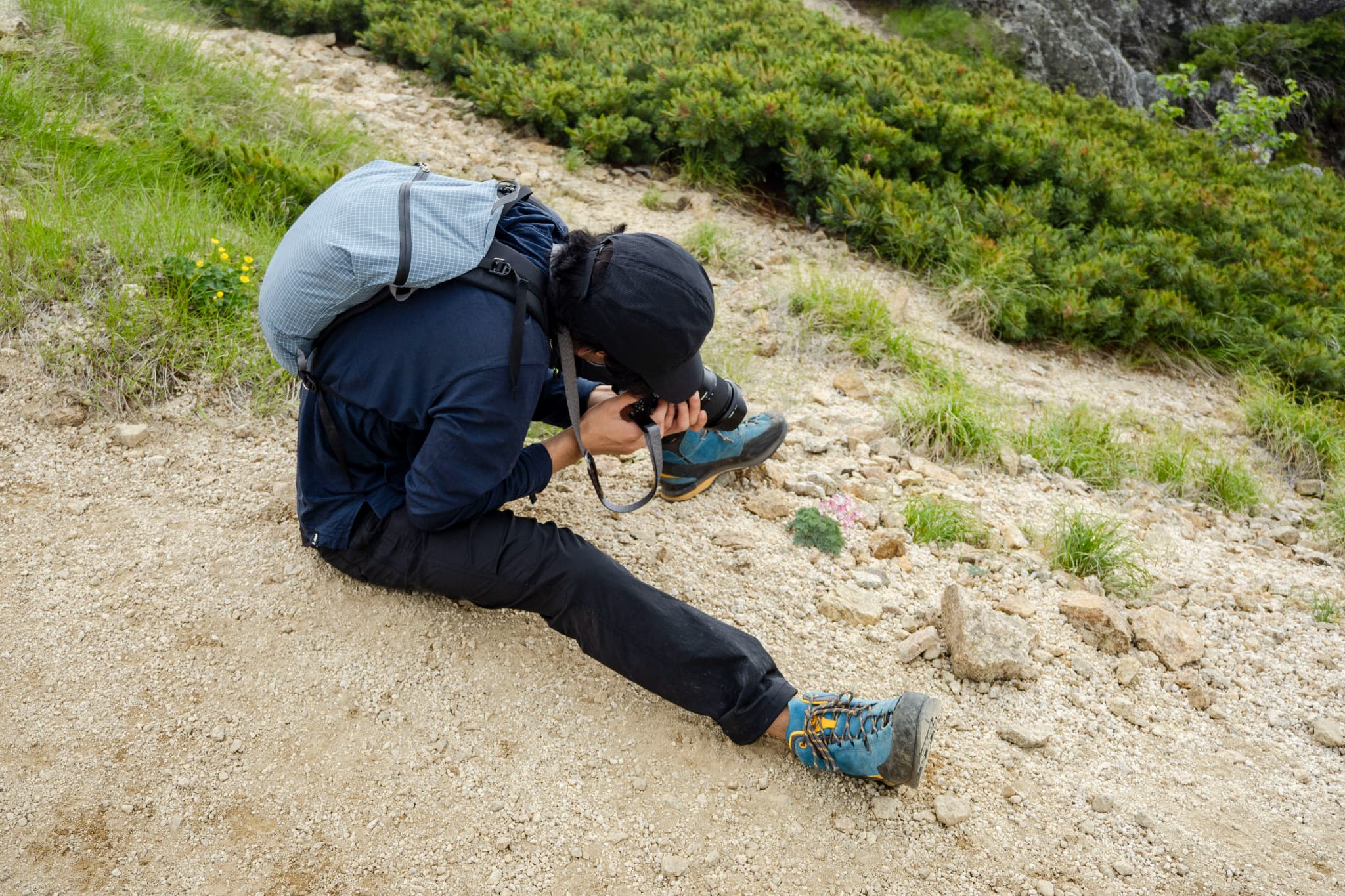
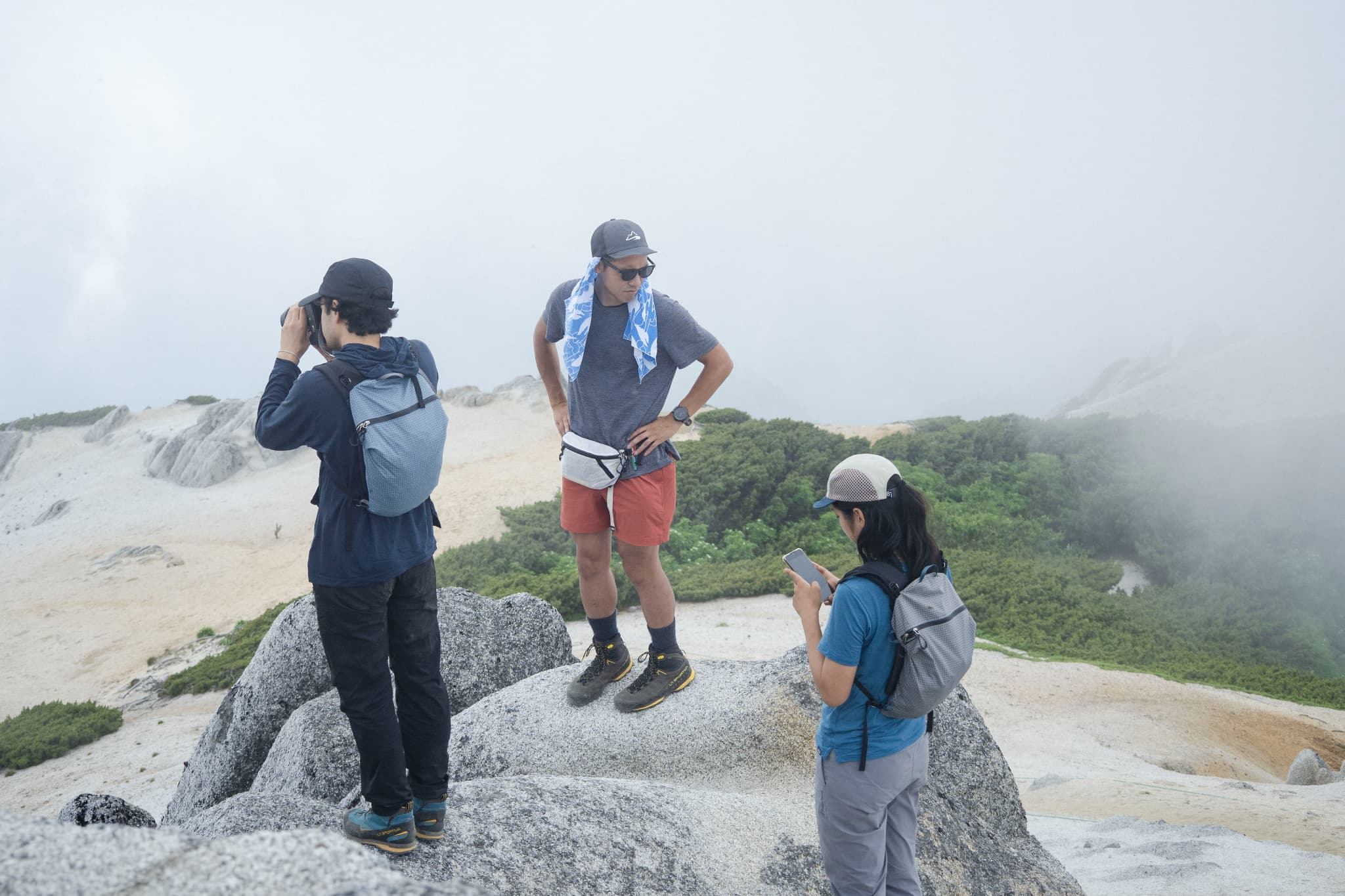
Knorr’s Voice
On this trip we made two peak-bagging side trips—Mt. Tsubakuro today and Mt. Yari at the end. Carrying first-aid, extra layers, rain gear, and water for a one-hour round-trip felt a bit much for a waist-pouch. But hanging a camera on my chest clashes with a pouch.
The solution was ZENN’s detachable front pocket, which turns into a mini-day-pack by connecting it to the pack’s back panel and harness—perfect for quick camera moves whenever the clouds broke.
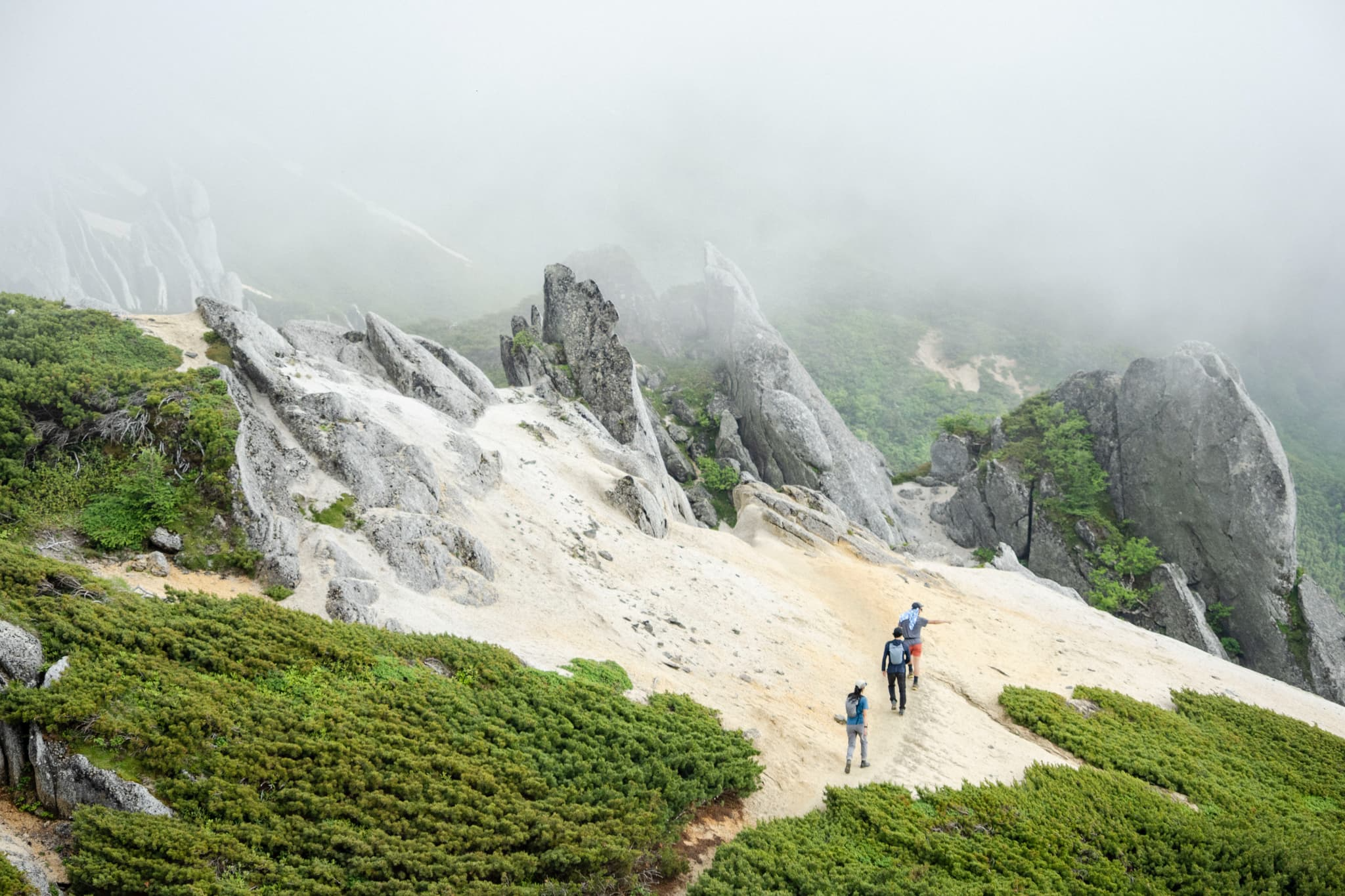
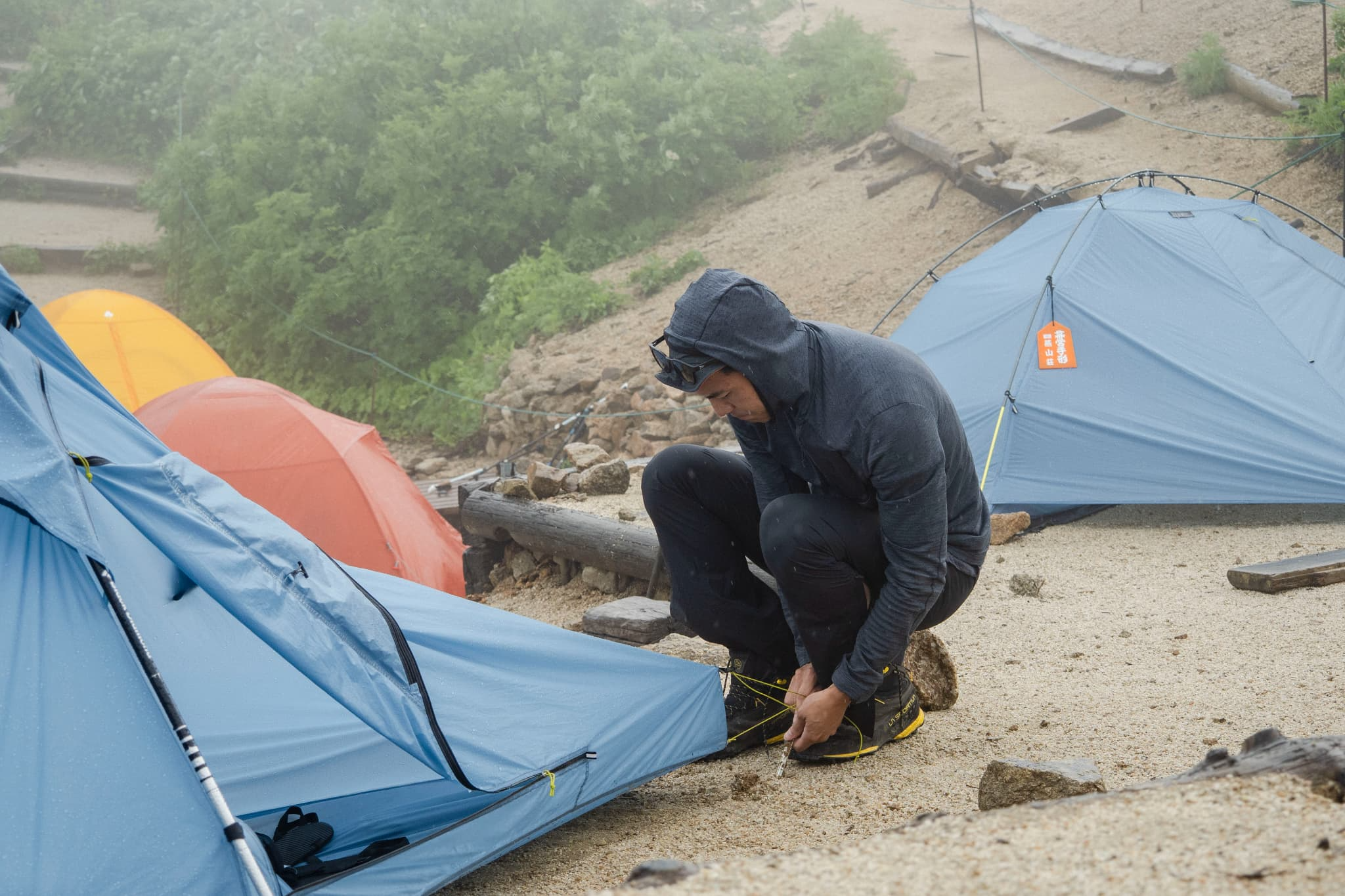
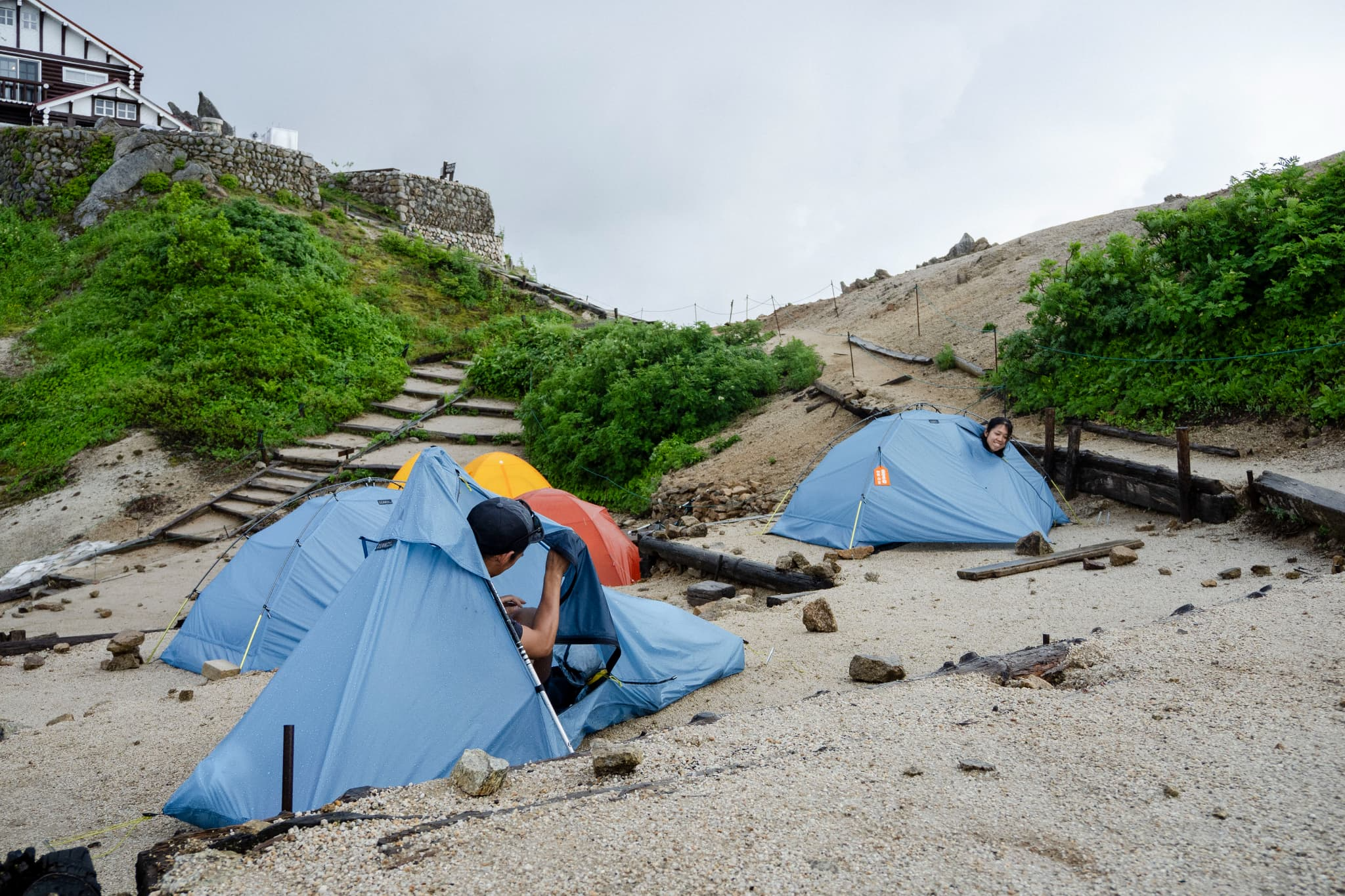
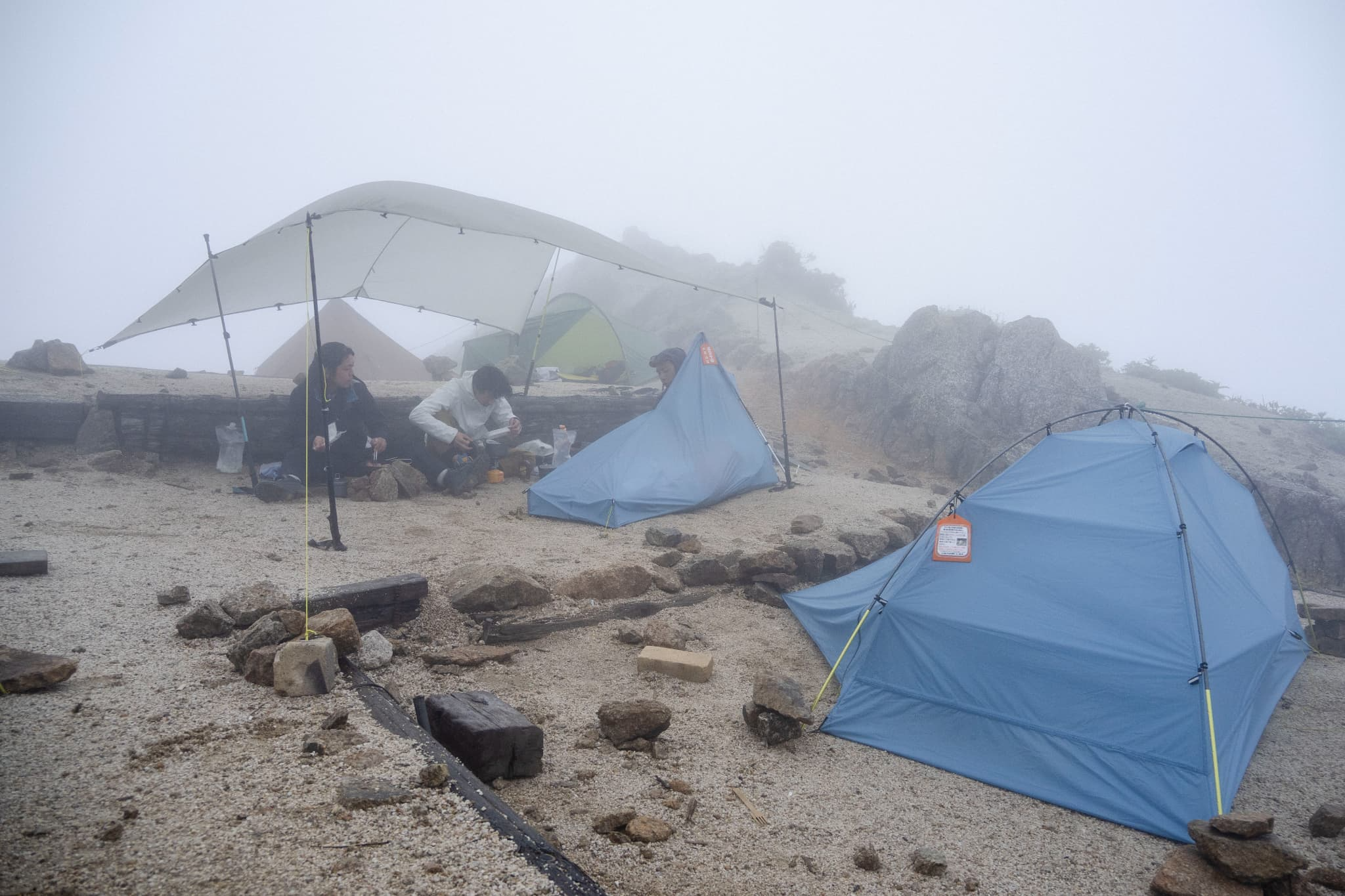
While we dawdled on Mt. Tsubakuro an abrupt downpour hit. Summer Alps often brew cumulonimbus and afternoon thunderstorms. We dived into the shelters, and when the rain eased set up a NINJA TARP as a roof. This 280-cm lightweight bestseller is ideal for extra living space and cooking in wet weather—especially with a group—so pair it with any ZENN shelter.
Dinner at last! Being day one, everyone flaunted fancy ingredients.
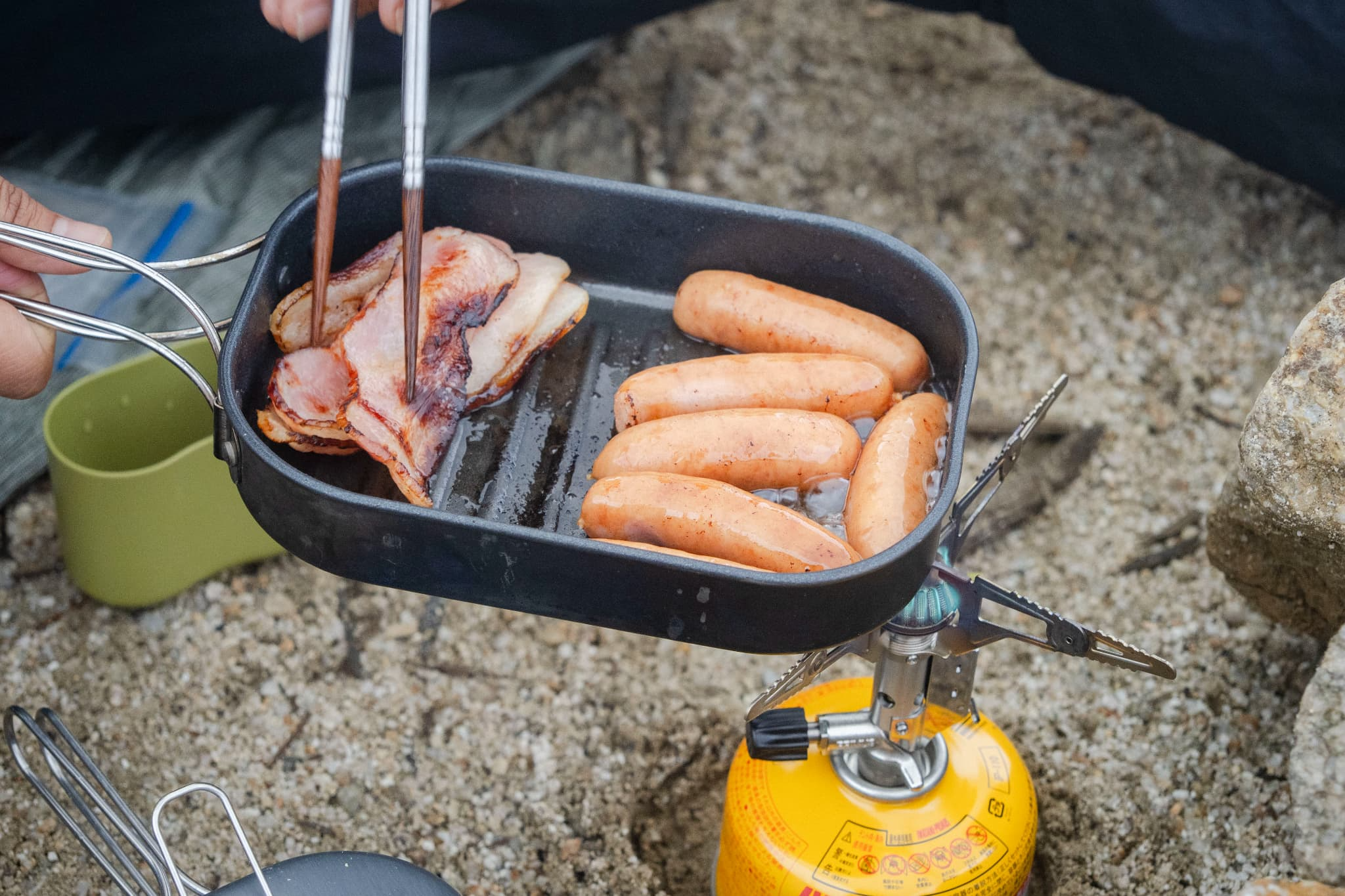
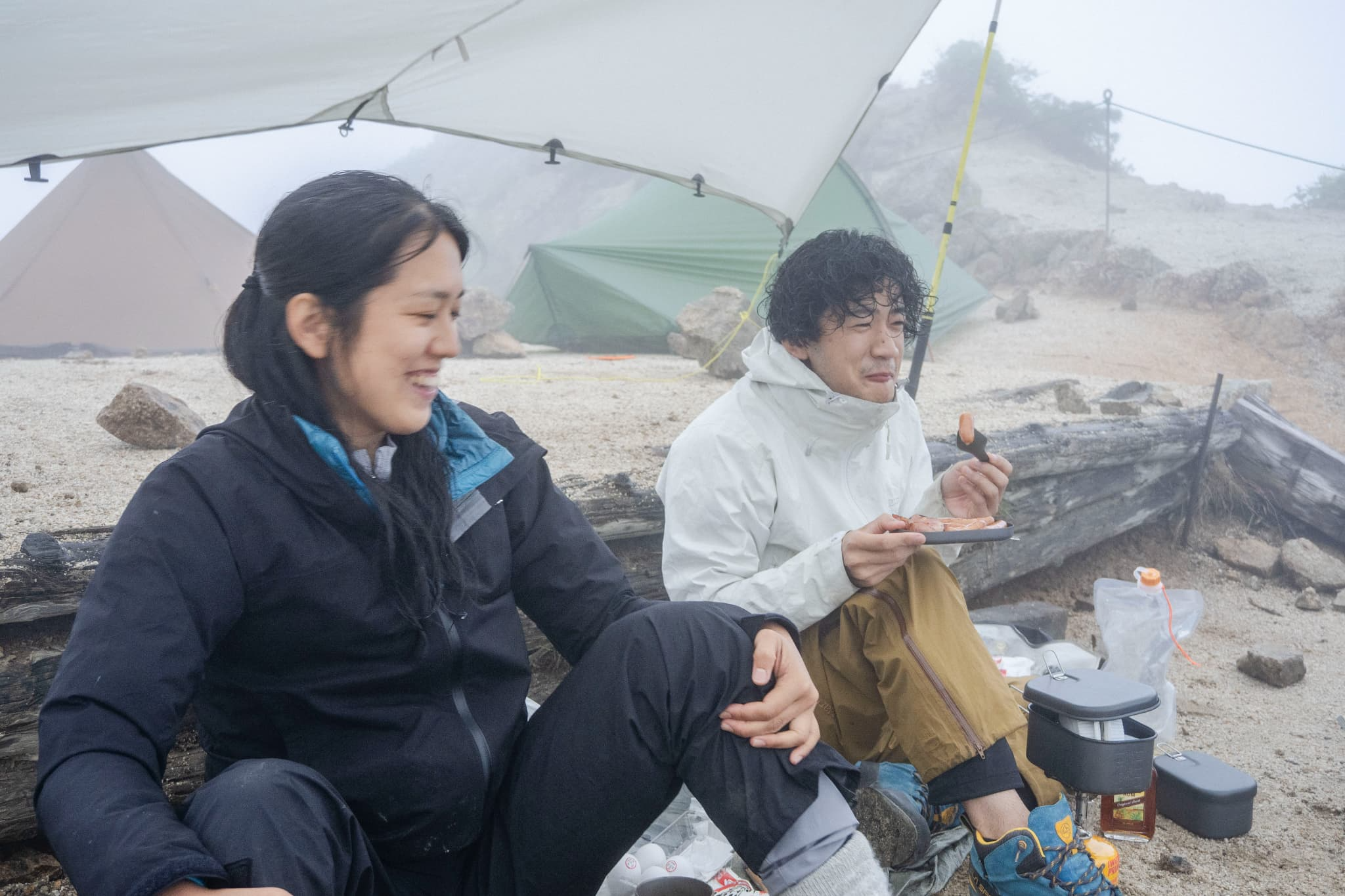
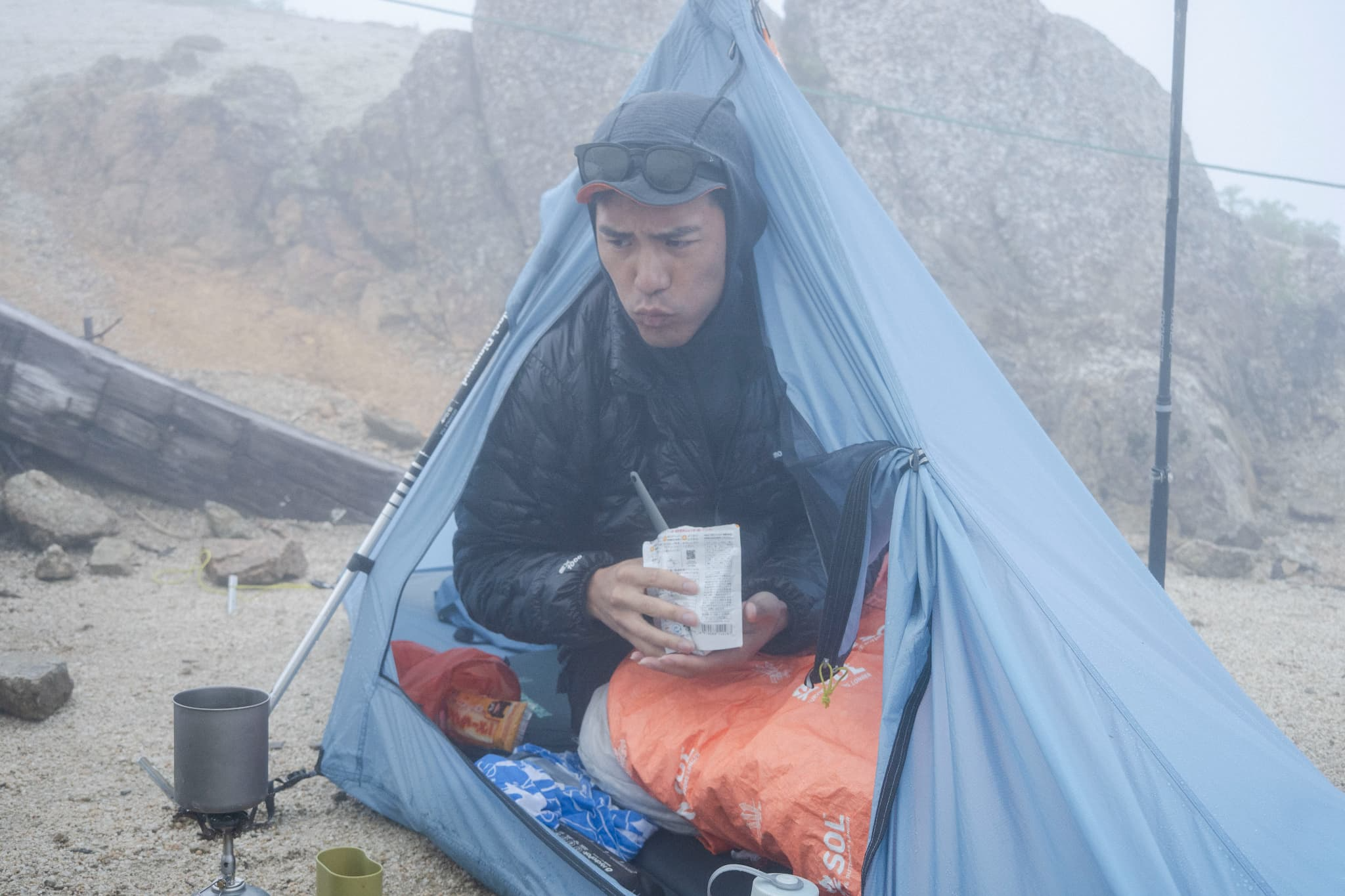
Ume’s Voice
I used the ZENN 2 POLE SHELTER. Space is tight, but it’s bottle-light and its tiny footprint fits cramped alpine campsites. Pitching is fast—stake four corners, insert poles, and it stands; I could be resting inside in five minutes.
In the downpour it neither flooded nor collapsed. Head space is roomy, so no claustrophobia—actually quite cozy.
My second tent-camp climb ever: I arrived at camp feeling strong, but after a short nap a headache hit. I forced myself up for the Tsubakuro side trip, but felt worse while boiling water afterward—no appetite. Altitude sickness? I worried about burdening the team.
Then the photographer asked, “Have you had any salt?” I’d sweated a river without electrolyte intake. A salt tablet and ten minutes later I was back, finishing my half-eaten rice. Mild heat exhaustion—glad I bounced back!
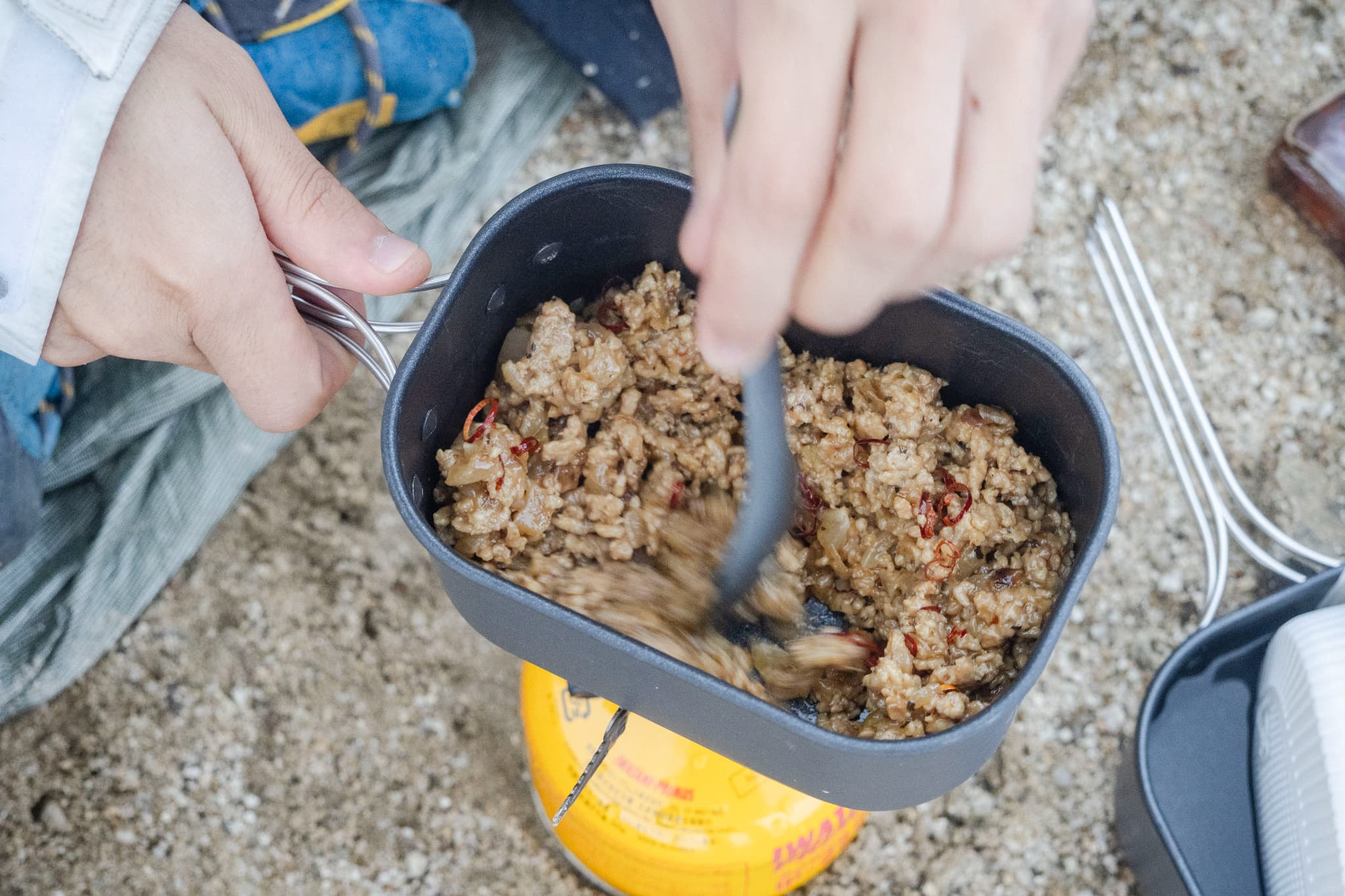
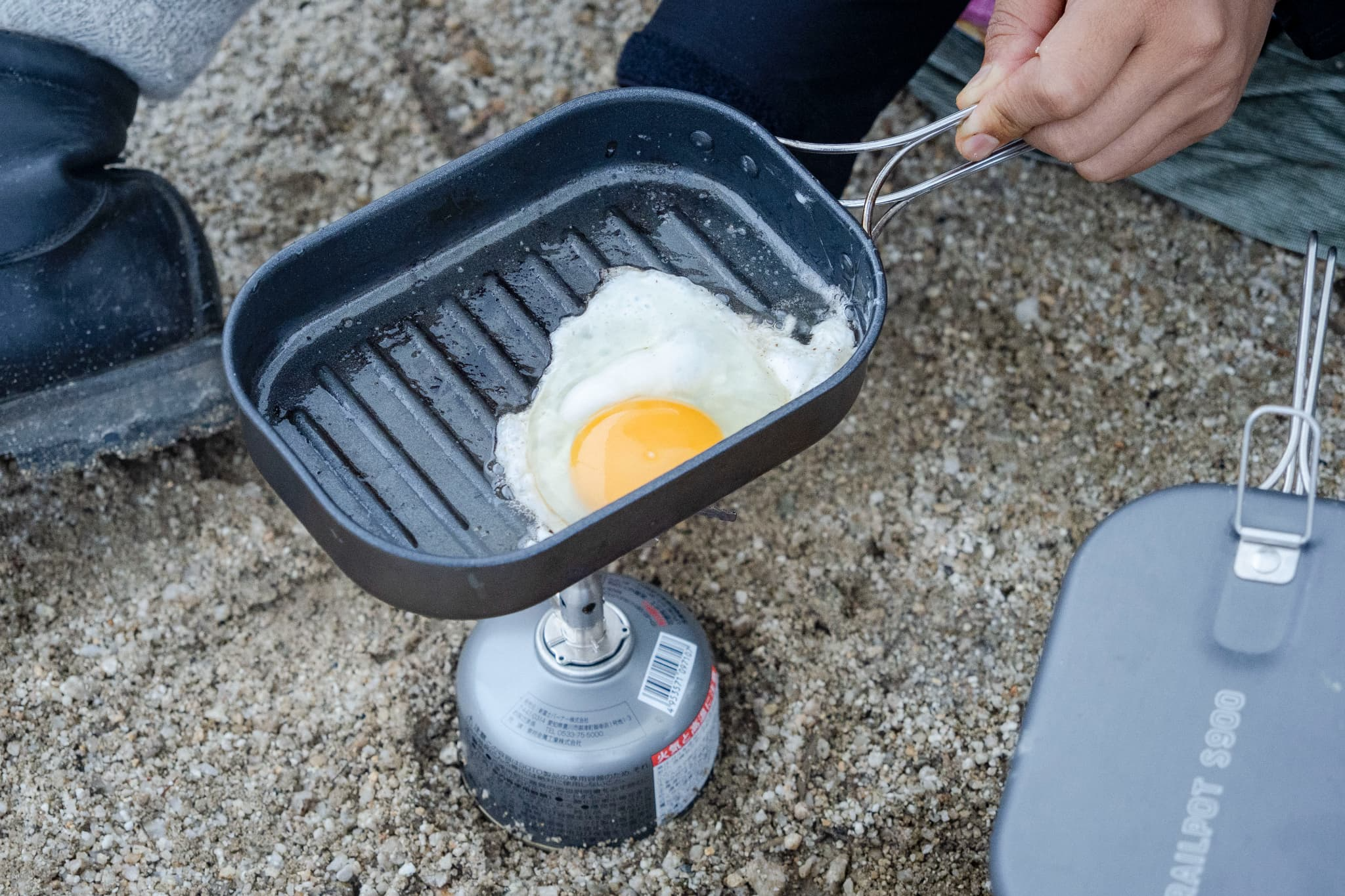
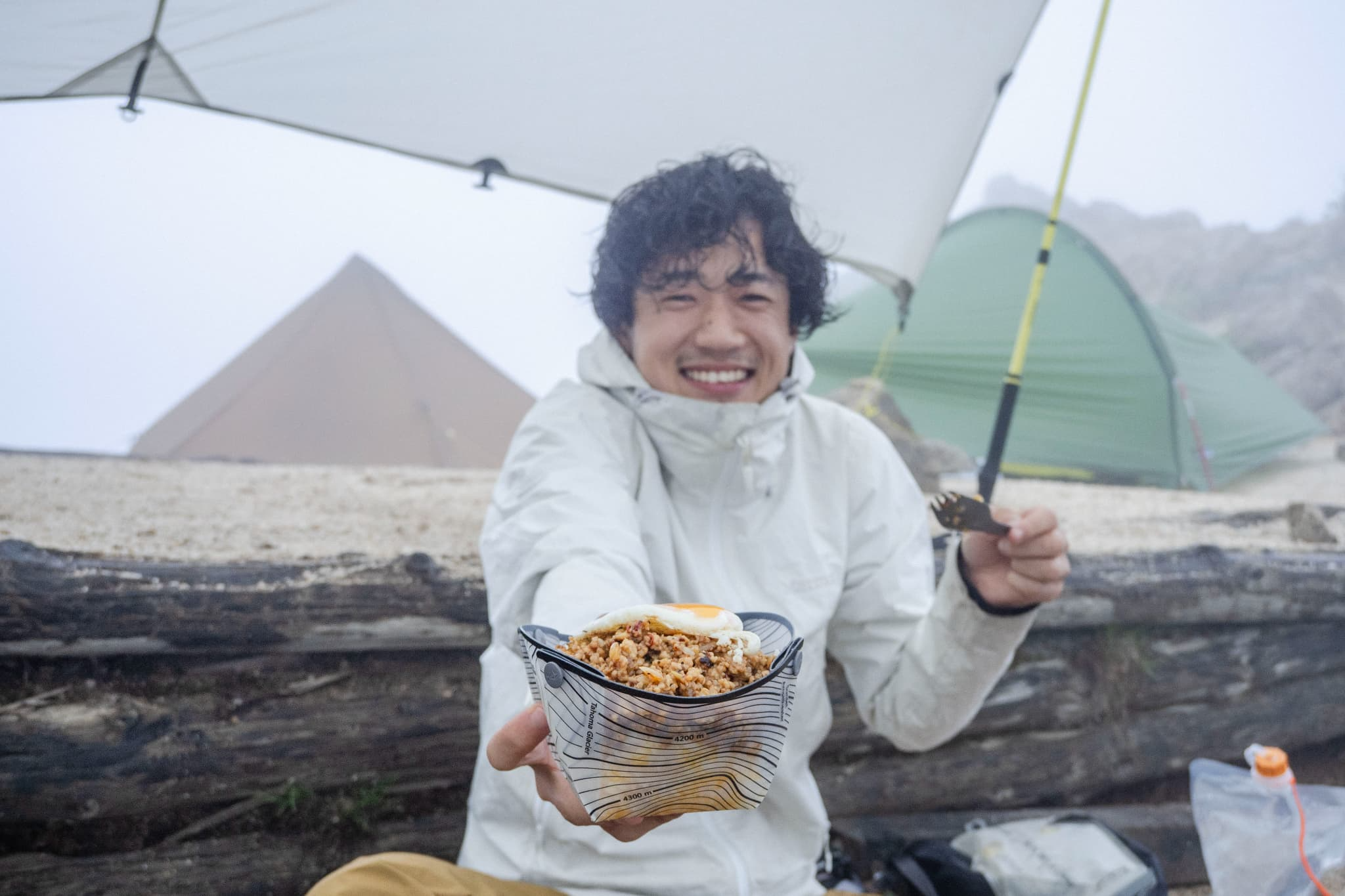
Knorr’s Voice
My hidden theme this trip was food. First, my gear: by choosing ultralight big items and using the roomy ZENN 45, I had space for extra ingredients.
Second, revenge—I botched every meal on this same route last year. Plenty of food is useless if it tastes bad. Lesson learned, I vowed to “never step on the same rake twice.”
Mountain-club tradition says meat on the first night. I went big with gapao rice crowned by fried eggs—carried fresh eggs by request! I feared sticking, but the TRAILPOT handled it. The spices and runny yolk smell were irresistible. Two servings of rice—tomorrow’s stage is long, so eat big and prep. Day one meal: success! I’ve got another treat for tomorrow. Calories? Who cares. Climb hard, eat hard, sleep!
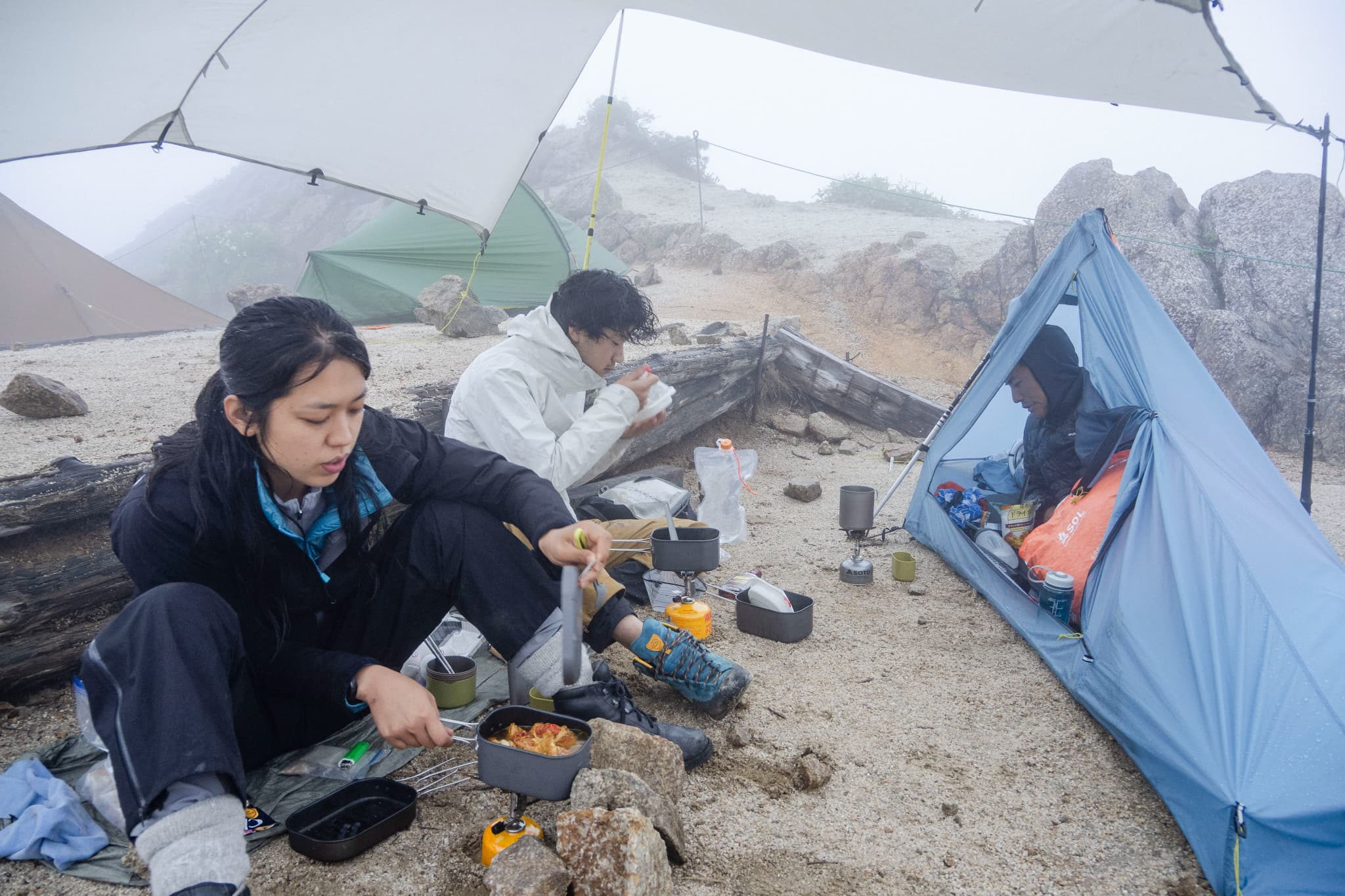
The joy of an alpine traverse isn’t just the vistas—it’s also food planning, comfortable and safe camps, and exercising your outdoor skills to savor time in the mountains. Even in summer, near 3,000 m temps drop to ~15 °C. Solid gear, planning, and technique are essential.
Tomorrow is the crux: a long traverse to Mt. Yari. As dusk settled we crawled into our sleeping bags.
DAY 2 — Along the Grand Ridgeline!
Start: 3 a.m. A 9-plus-hour day to Mt. Yari plus afternoon-thunderstorm risk demanded an early start. Rain fell all night but stopped just before departure—relief. Headlamps on, we headed for Mt. Ōtenjō.
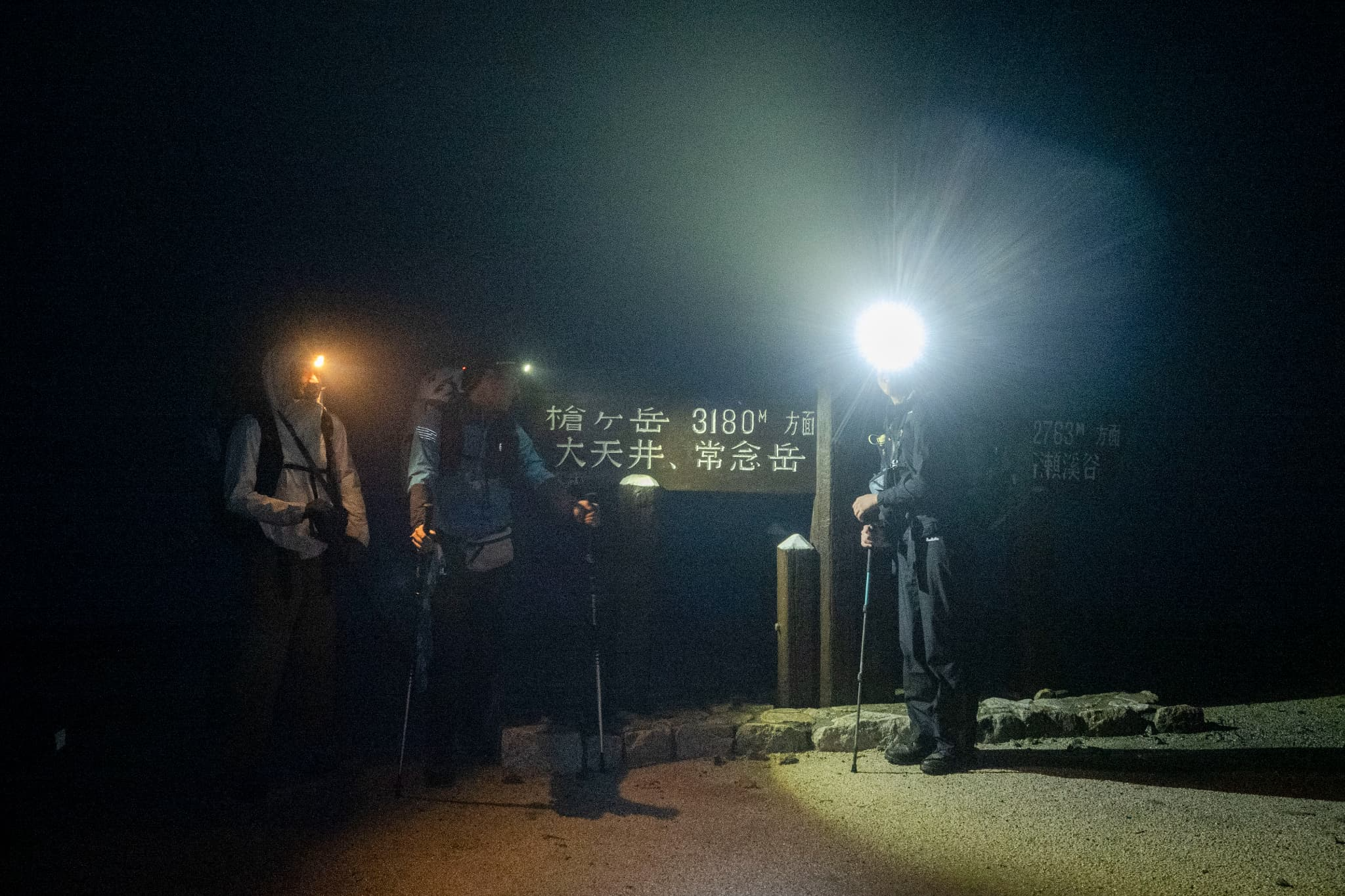
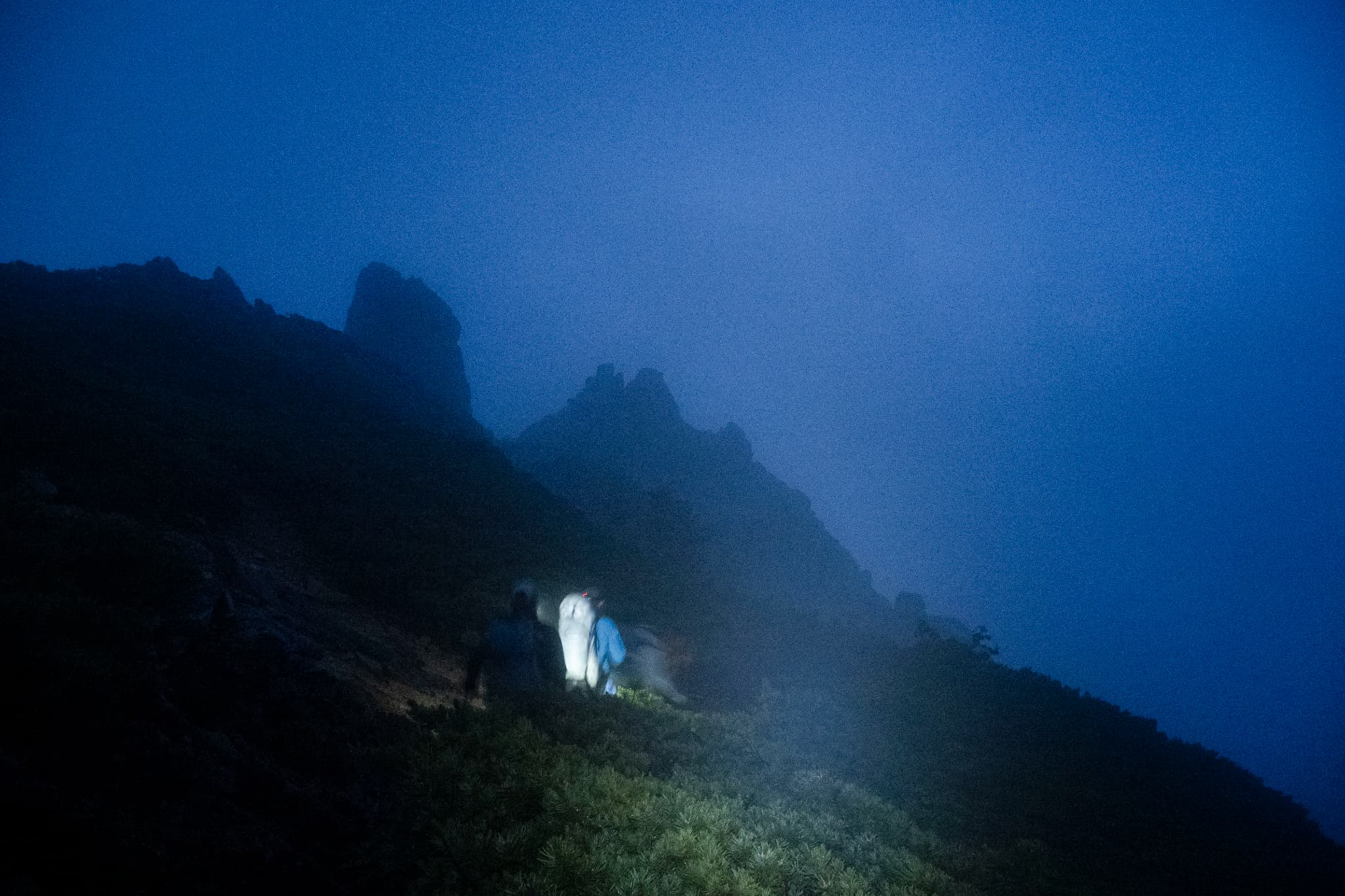
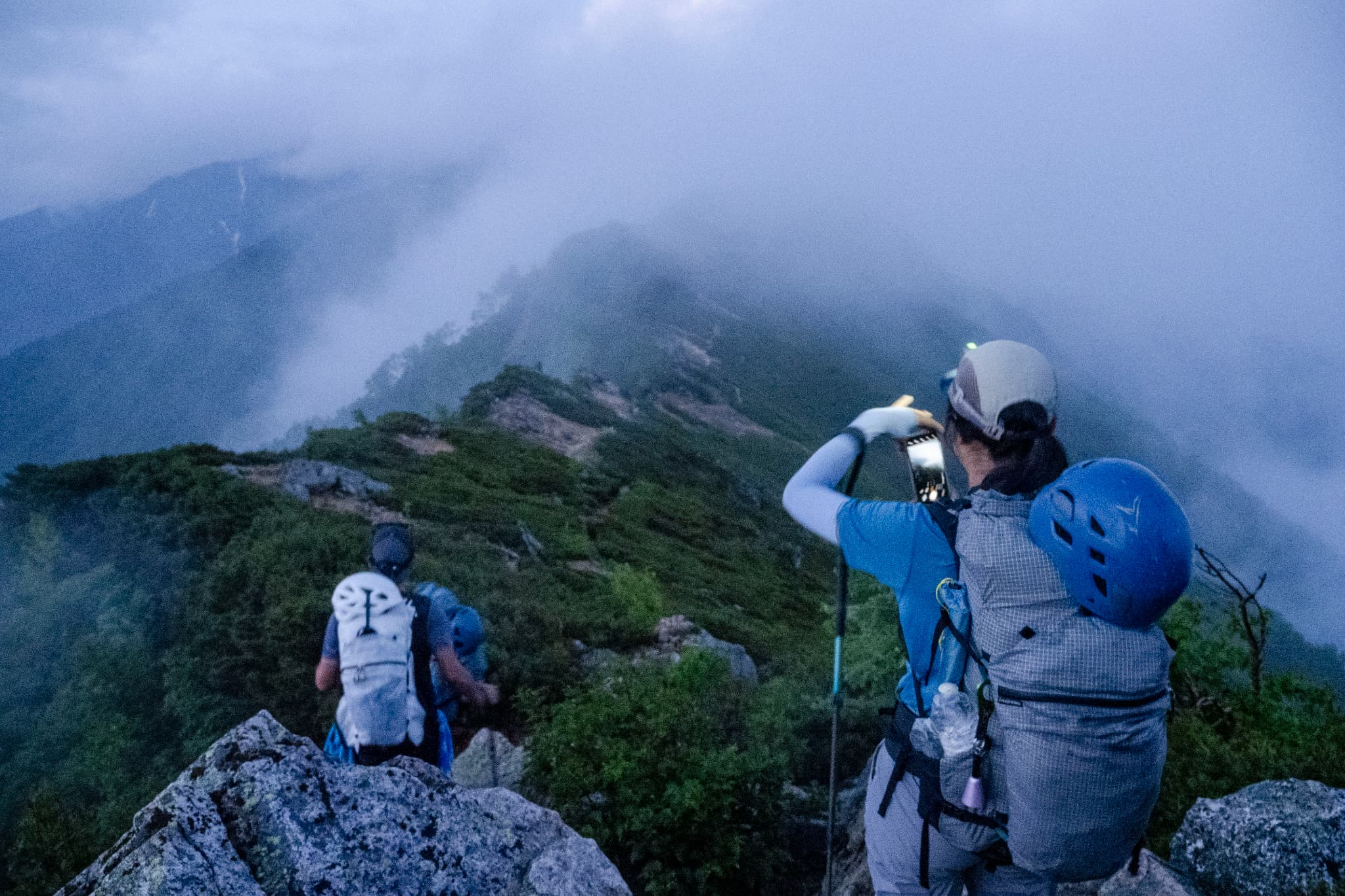
The ridge from Tsubakuro to Ōtenjō is mostly gentle—an enjoyable line. If Yari feels too far, an out-and-back to Ōtenjō or a trip along the “Panorama Ginza” to Mts. Jōnen and Chō would be great alternatives. Thick fog hid distant peaks; we trudged on.
Shohoko’s Voice
It drizzled until the last minute, forecast rain after noon… We discussed and said, “Let’s at least reach Ōtenjō,” hurriedly striking the shelters when the rain paused.
Here I discovered a single-wall bonus: ZENN shelters are single-wall, so wiping condensation with a towel removes moisture quickly and packing is fast. My usual double-wall fly absorbs water and gets heavy—single-wall is lighter and easier! (Even single walls get heavy, so I stuffed the tent loose in a side pocket to dry while walking.)
“Please hold, weather!” I love pre-sunrise mountain hours, but the ridge ahead stayed hidden. I kept glancing at the sky, hoping the clouds would part.
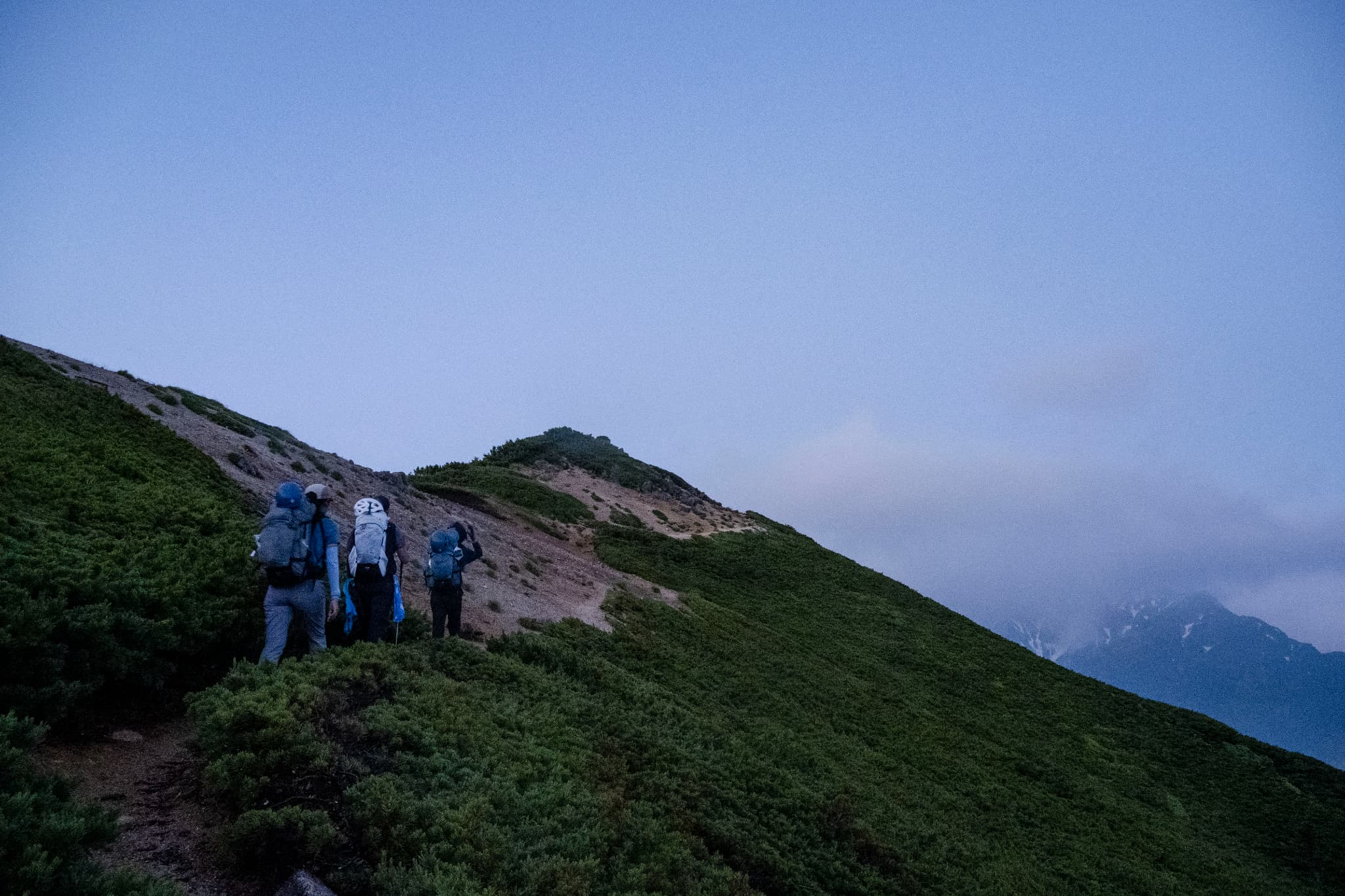
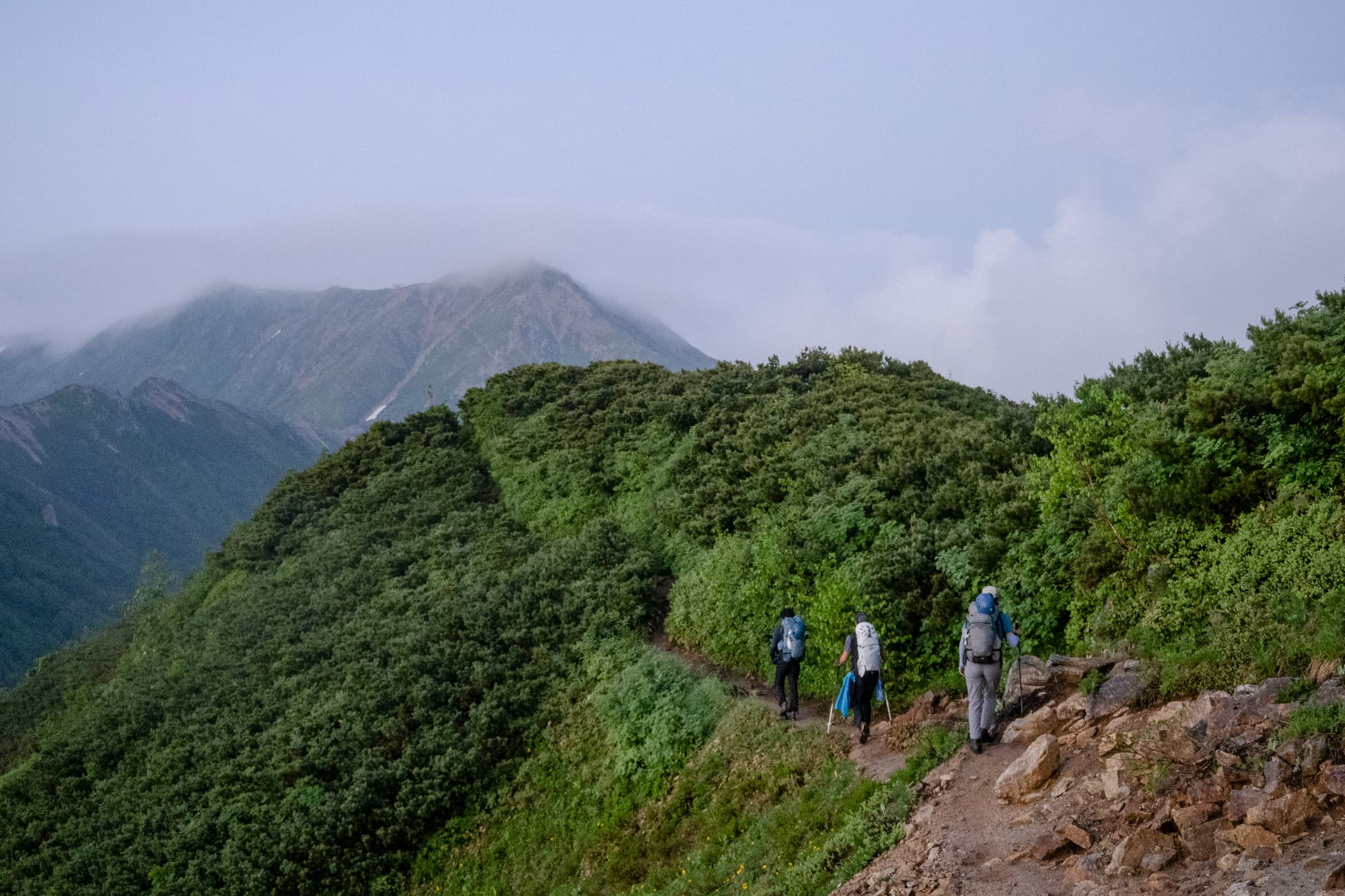
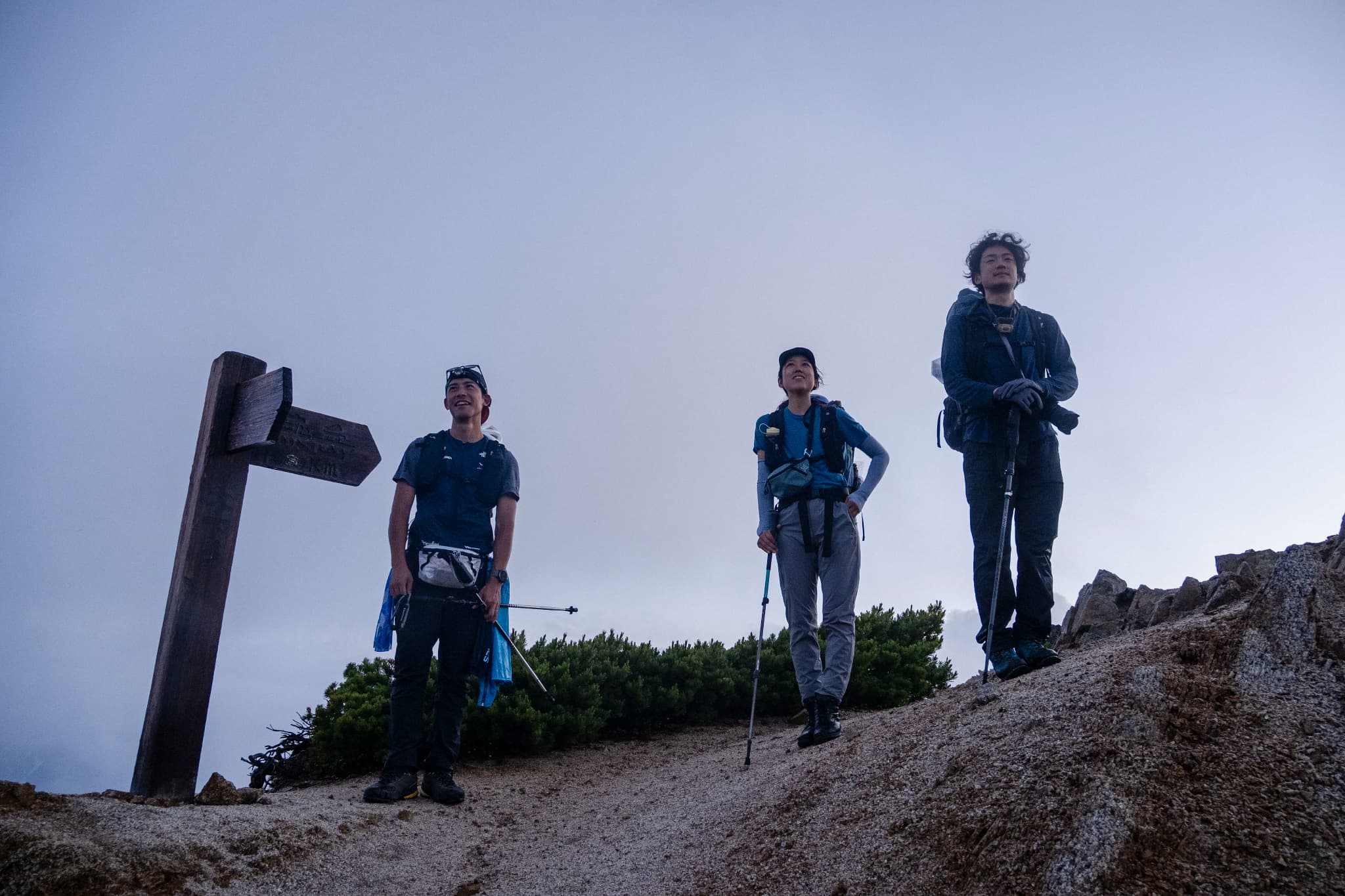
Ume’s Voice
Pre-dawn starts with headlamps are familiar from 100-mile races, so no hardship. I was actually lively. The ~10 kg ZENN stayed comfy. But the scale of the scenery crushed me more than once—cloud gaps revealed the ridgeline ahead AND final boss Mt. Yari. “We’re walking ALL of that, right?” Trail-running routes rarely feel so vast. Seeing each peak I kept checking the course time: “Really only 15 min to that point?”
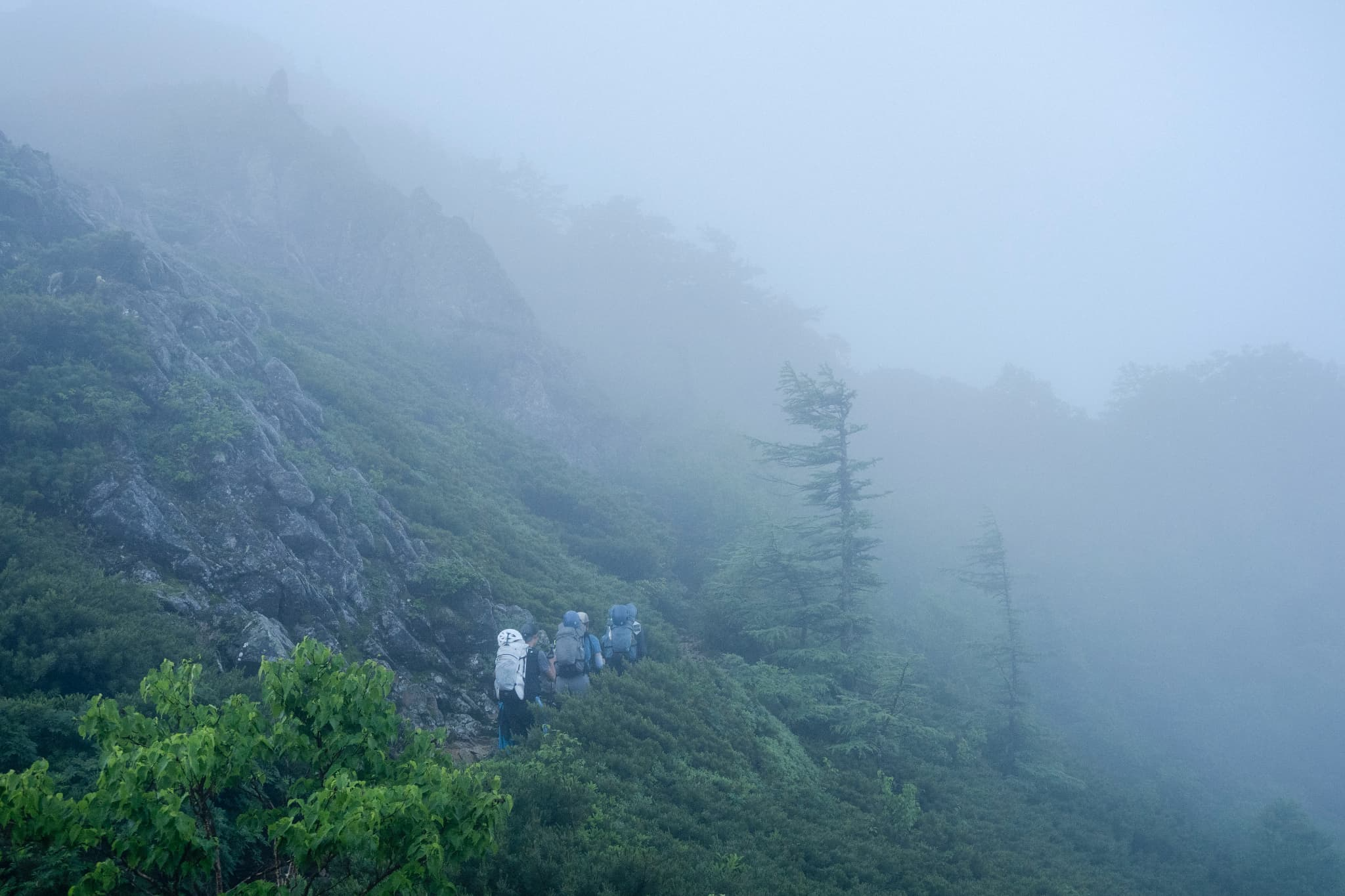
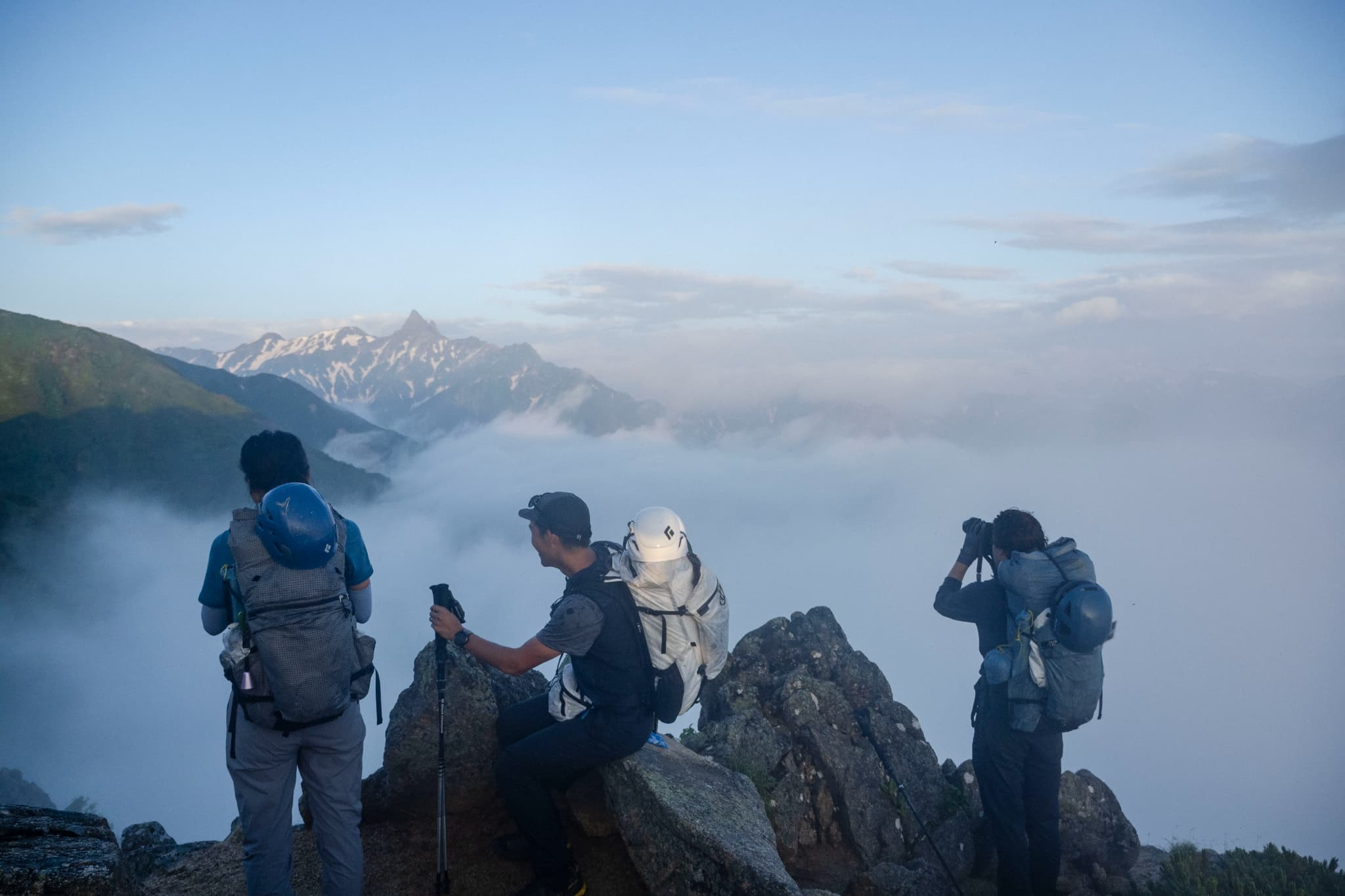
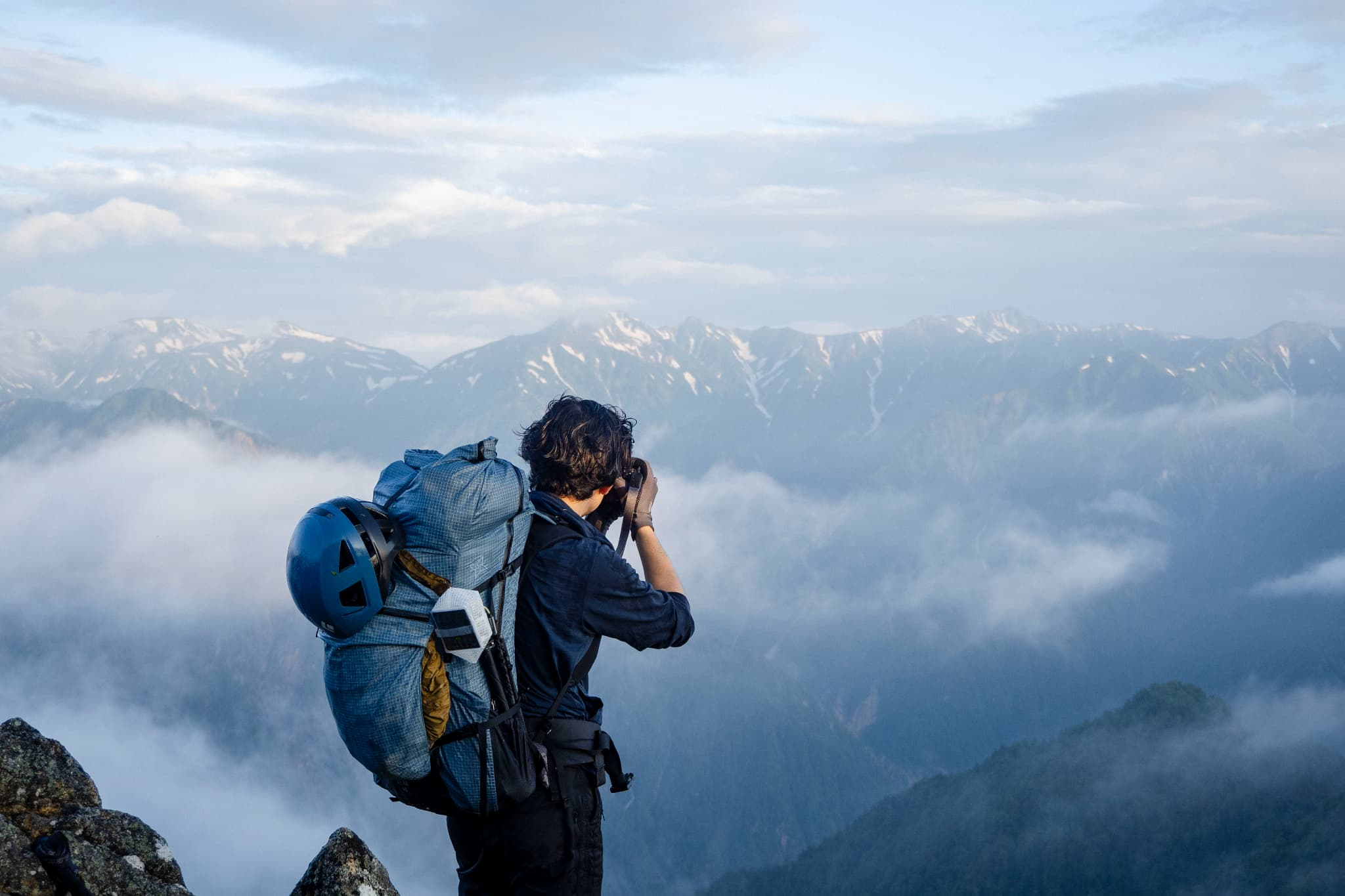
Knorr’s Voice
My favorite mountain time is dawn: headlamp off-on borderline light. We prayed for clear weather and moved through the dark.
Sunrise was breathtaking—a ridge shifting from ultramarine to purple to orange. Clouds drifted around the path ahead, surreal. I slowed, lost in photography.
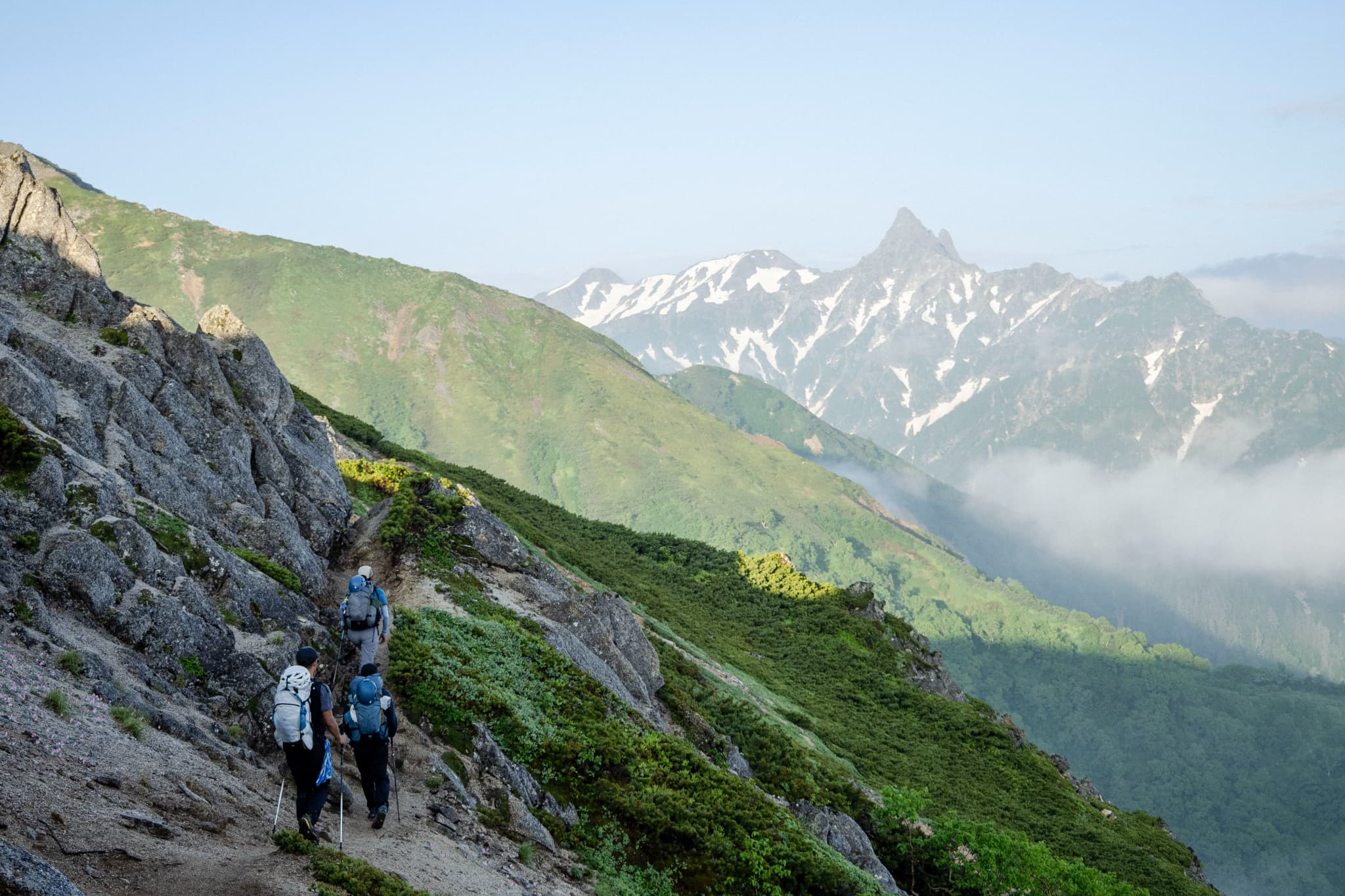
Clear morning sky and Yari views—this is the joy of traversing and Omote-Ginza’s charm. After yesterday’s rain, the clear blue felt glorious… and a bit daunting, seeing how far we had to walk. Still, the views promised to keep coming.
Toward Mt. Ōtenjō
First peak of the day: Mt. Ōtenjō, its hefty green bulk glowing under summer skies.
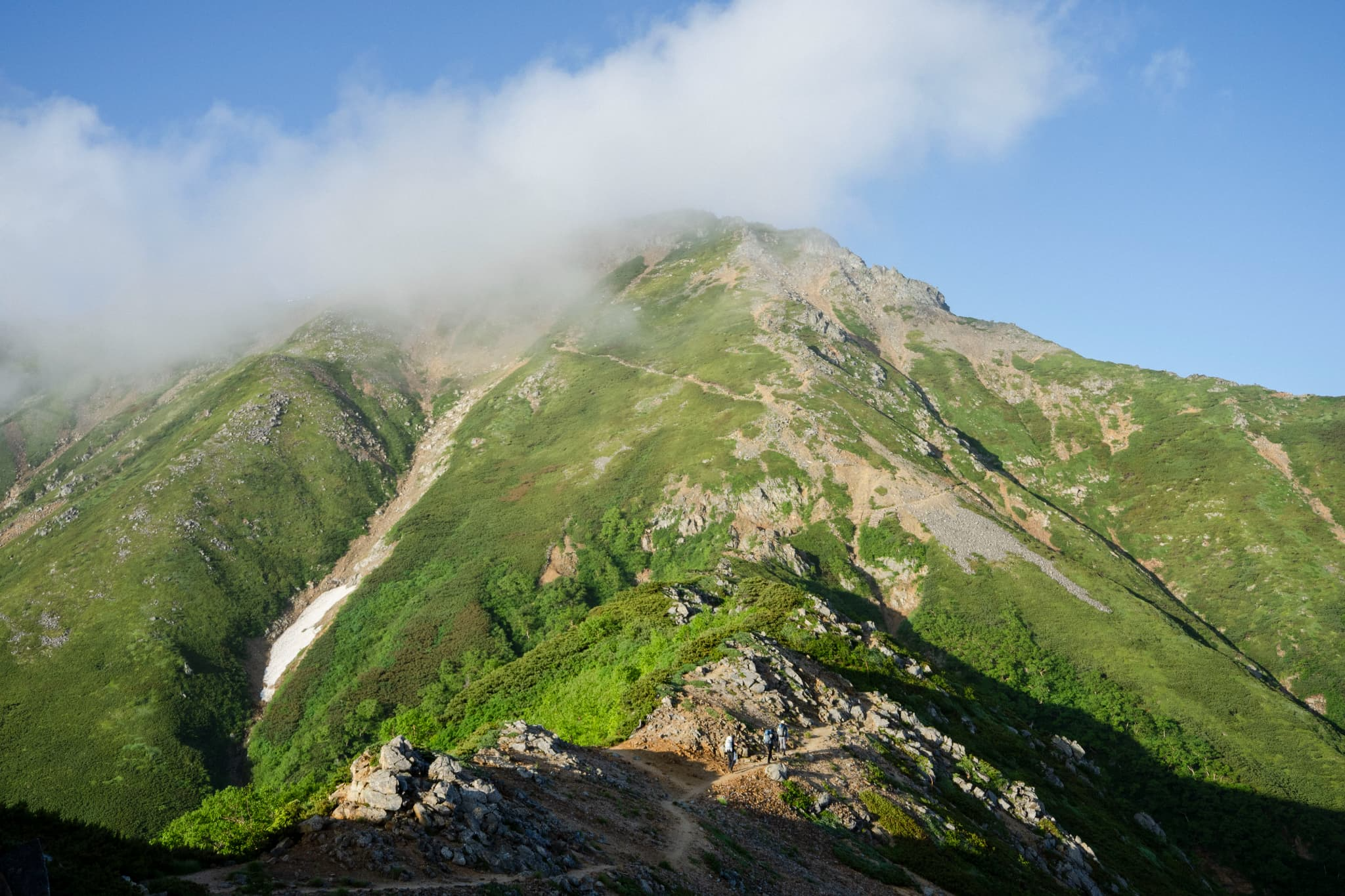
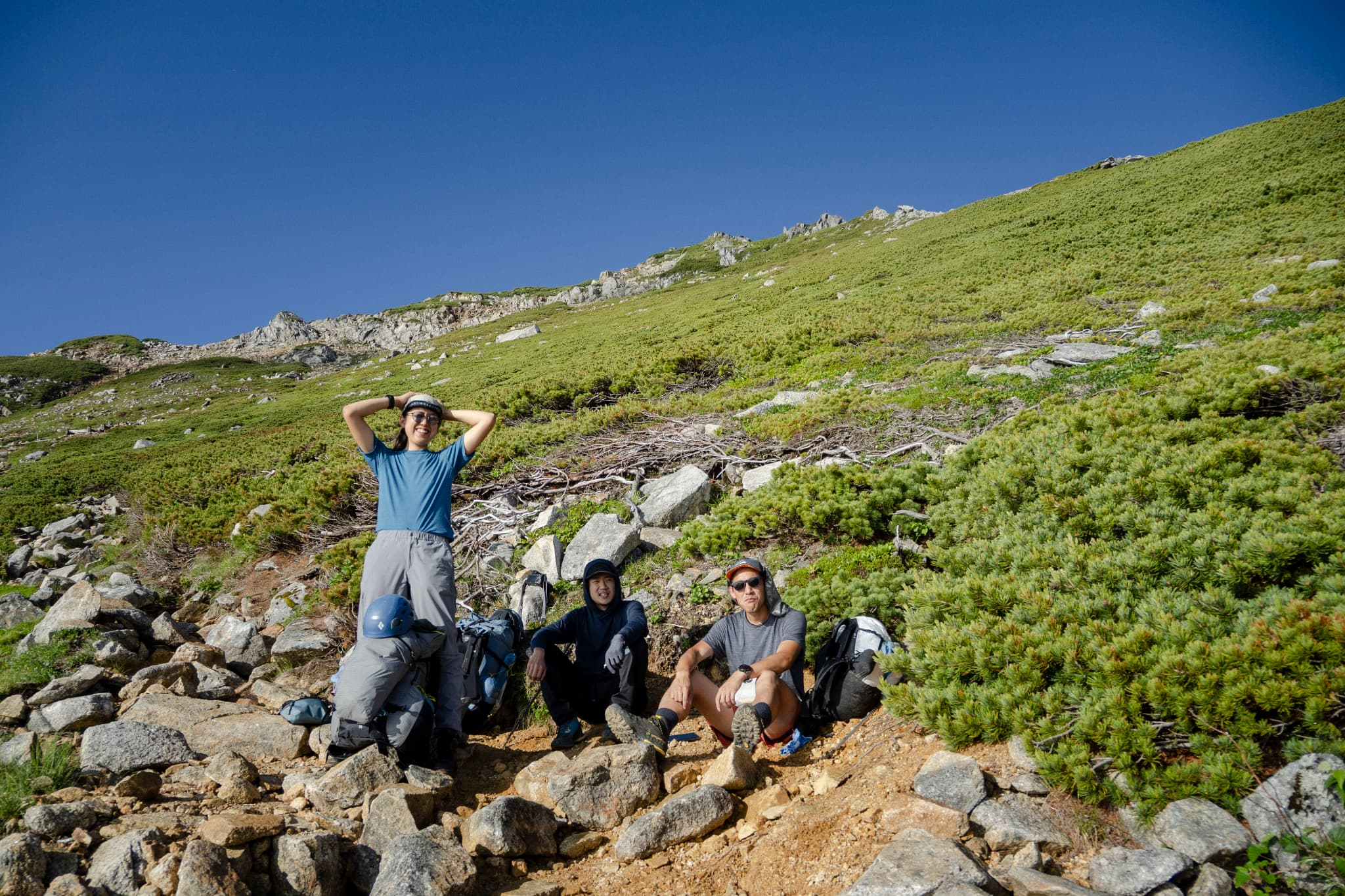
Shohoko’s Voice
The way to Ōtenjō was long! The blazing sun and steep climb drained me, so reaching the top felt amazing. The Northern Alps and Tateyama panorama took my breath away.
Reading cloud movement, we decided to push to Yari. Rain clouds in the distance and the rugged path ahead made me a little anxious as we left Ōtenjō.
Summer weather changes quickly—forecast alone isn’t enough; you must judge on site. We were lucky: little wind meant lower hypothermia risk even if rain hit. Still, rain/wind protection is non-negotiable even when cutting weight. Pre-planned escape routes and criteria are equally vital.
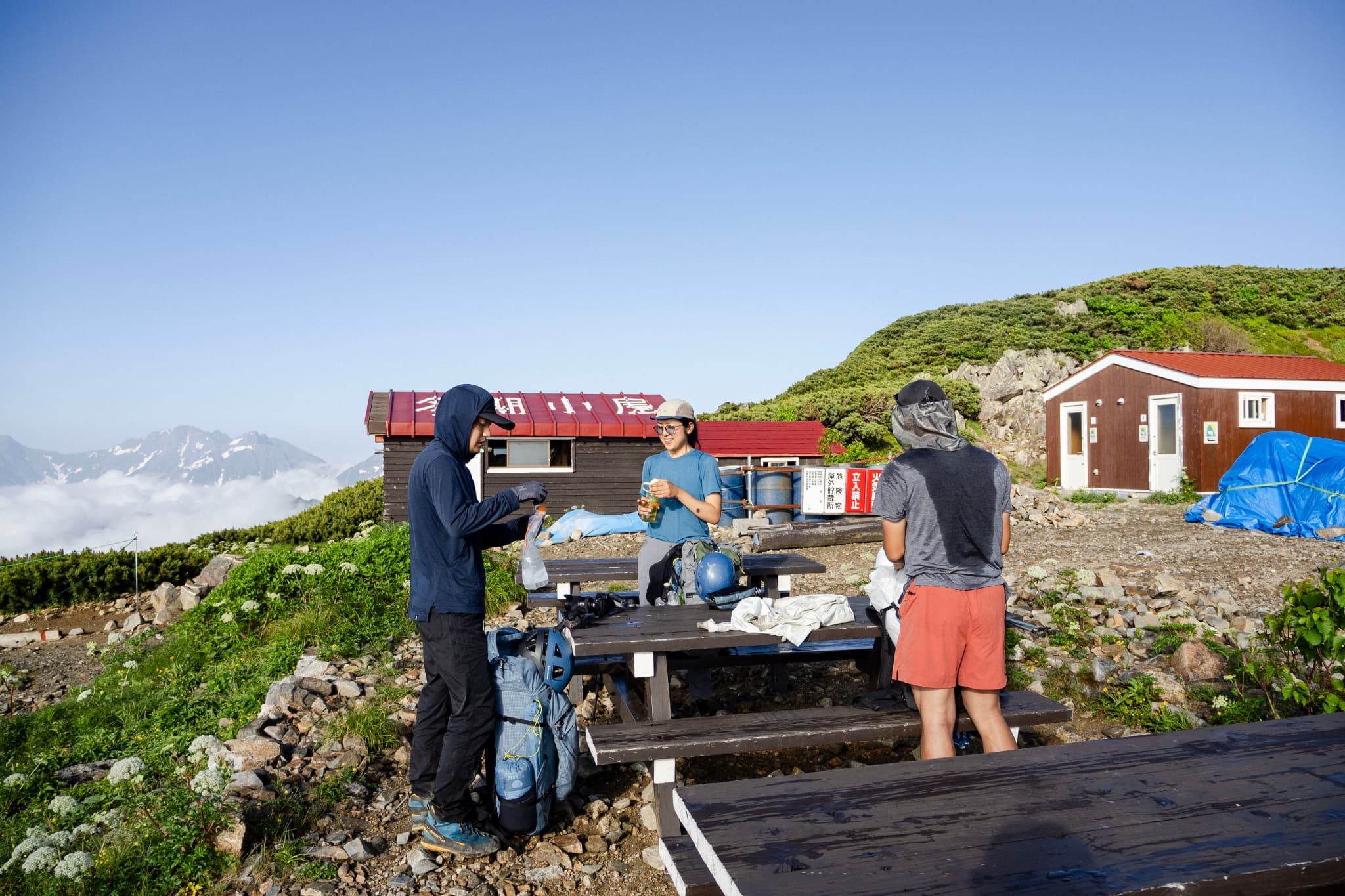
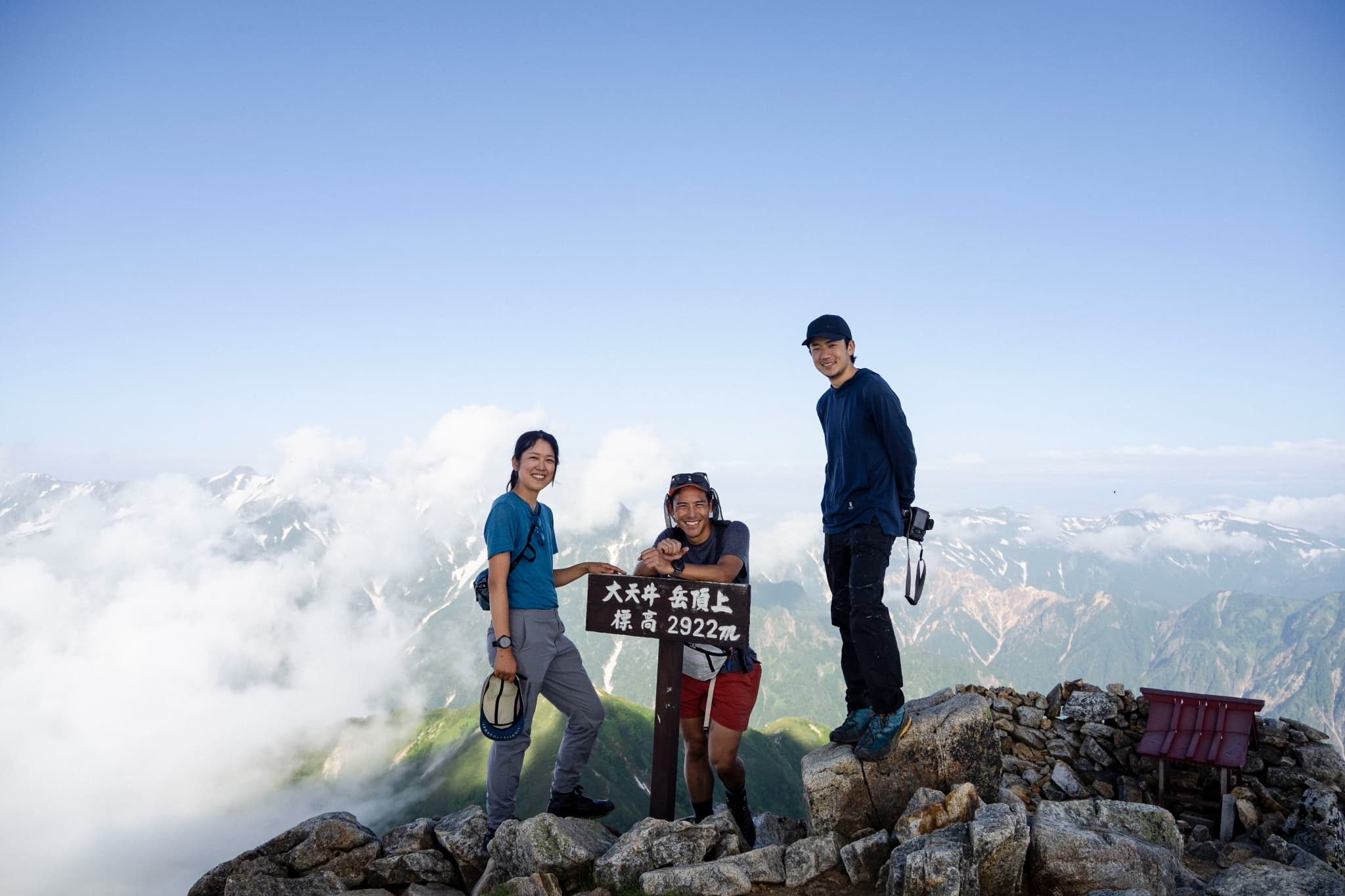
Knorr’s Voice
The closer a peak looks, the farther it really is—that was Ōtenjō’s lesson. Sunrise heat and endless switchbacks slowed me. Morale dipped, but the summit view wiped the struggle clean—over and over, that’s the thrill of a traverse.
We reached the hut near the summit around 6:30 a.m.—a time I’d normally be snoozing at home! Enjoying a grand vista at that hour felt luxurious. Eight more hours of mountain time remained—immersion in adventure.
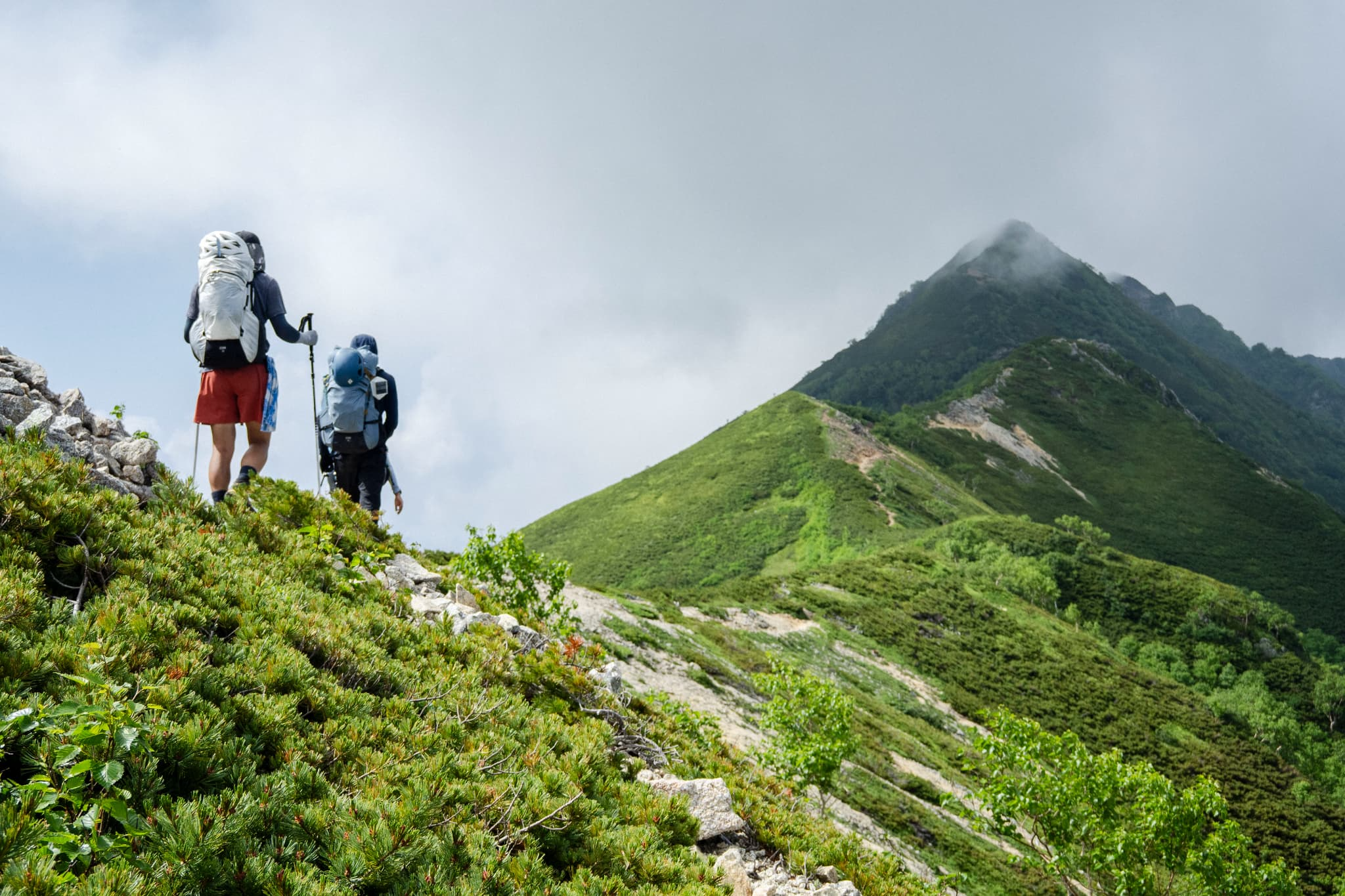
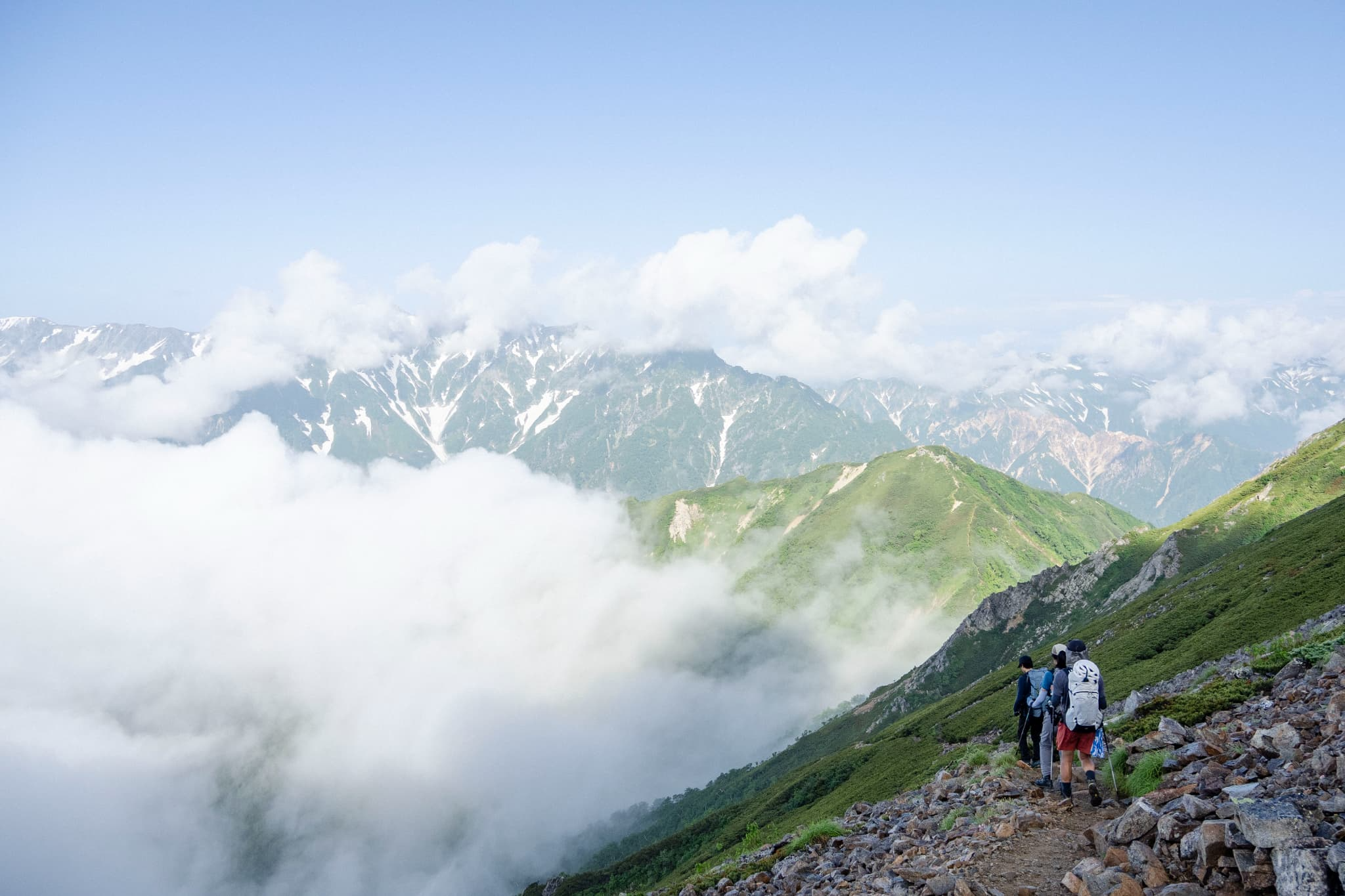
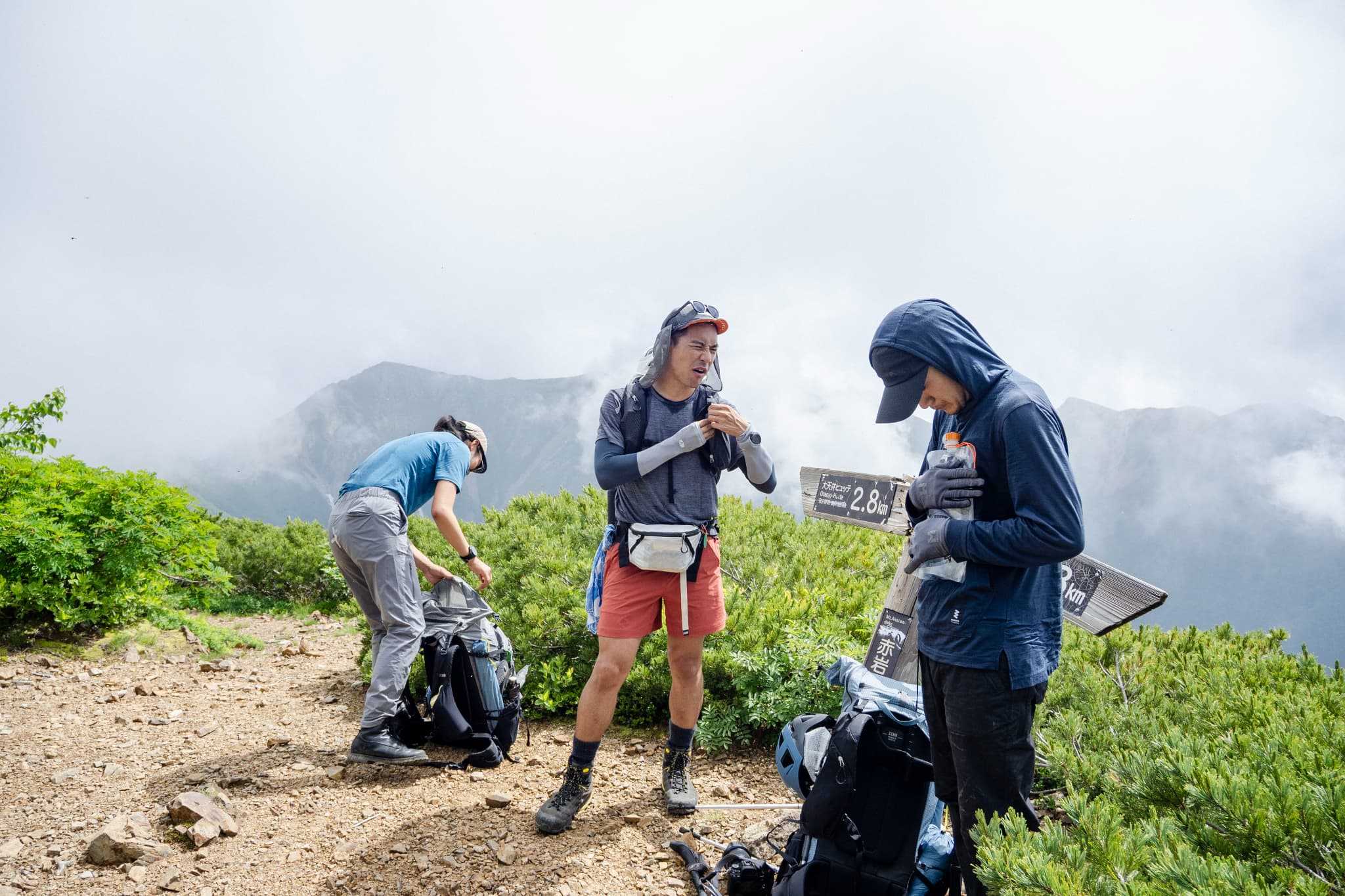
Ume’s Voice
Hot again—still sweating buckets. Lesson from yesterday: I munched salt tablets and slow-burn nuts. ZENN (善) is haste—use knowledge right away.
Even after Ōtenjō and Bikkuri-daira, we were only halfway. Depending on pace we might get rained on before reaching the Sessei Hütte camp, so no dawdling. The section traversed forested slopes—watch your footing—but raise your eyes and the endless Alpine panorama is unbelievable! Trail races rarely offer such views. I was already in love with traverse romance.
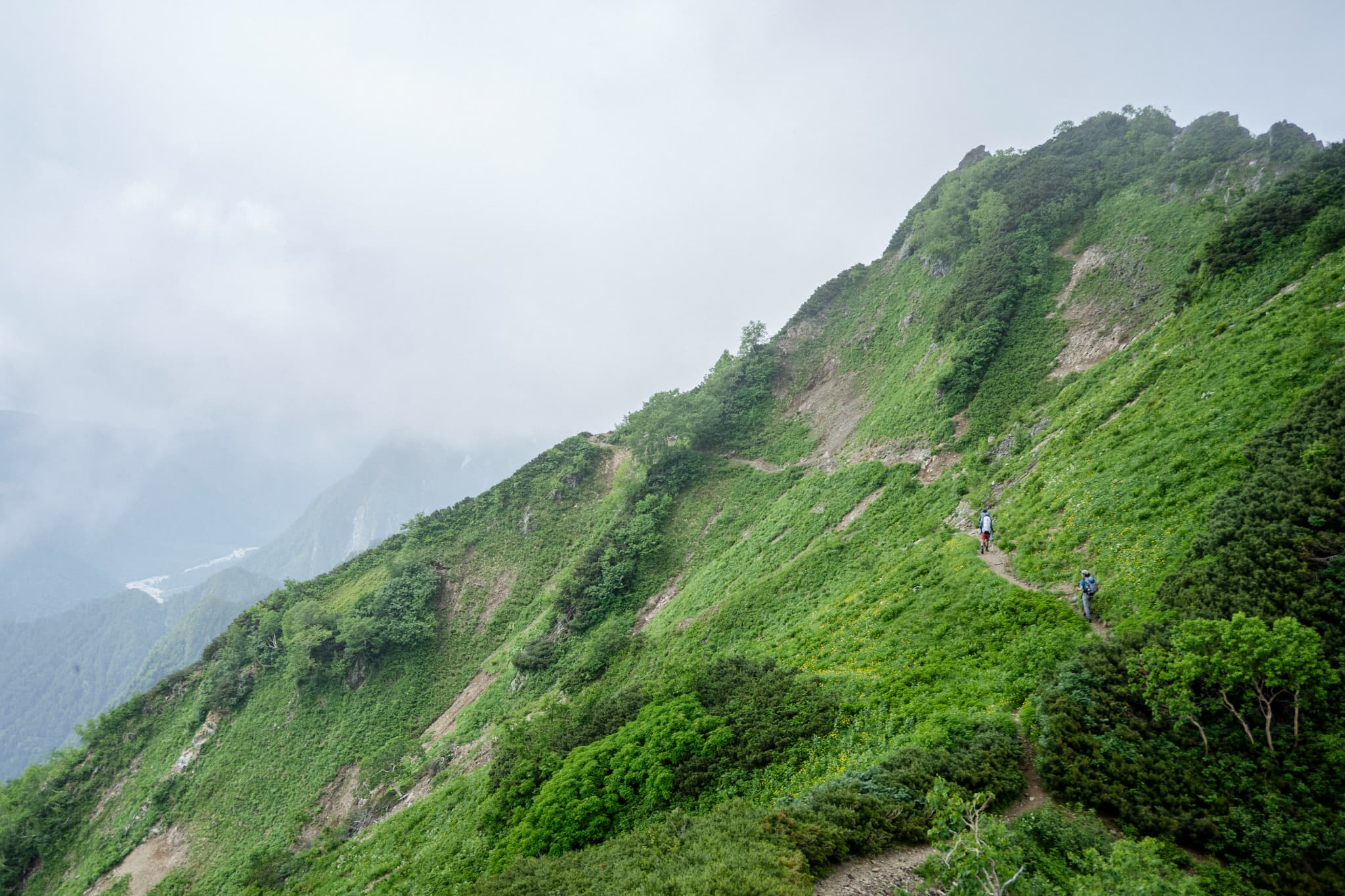
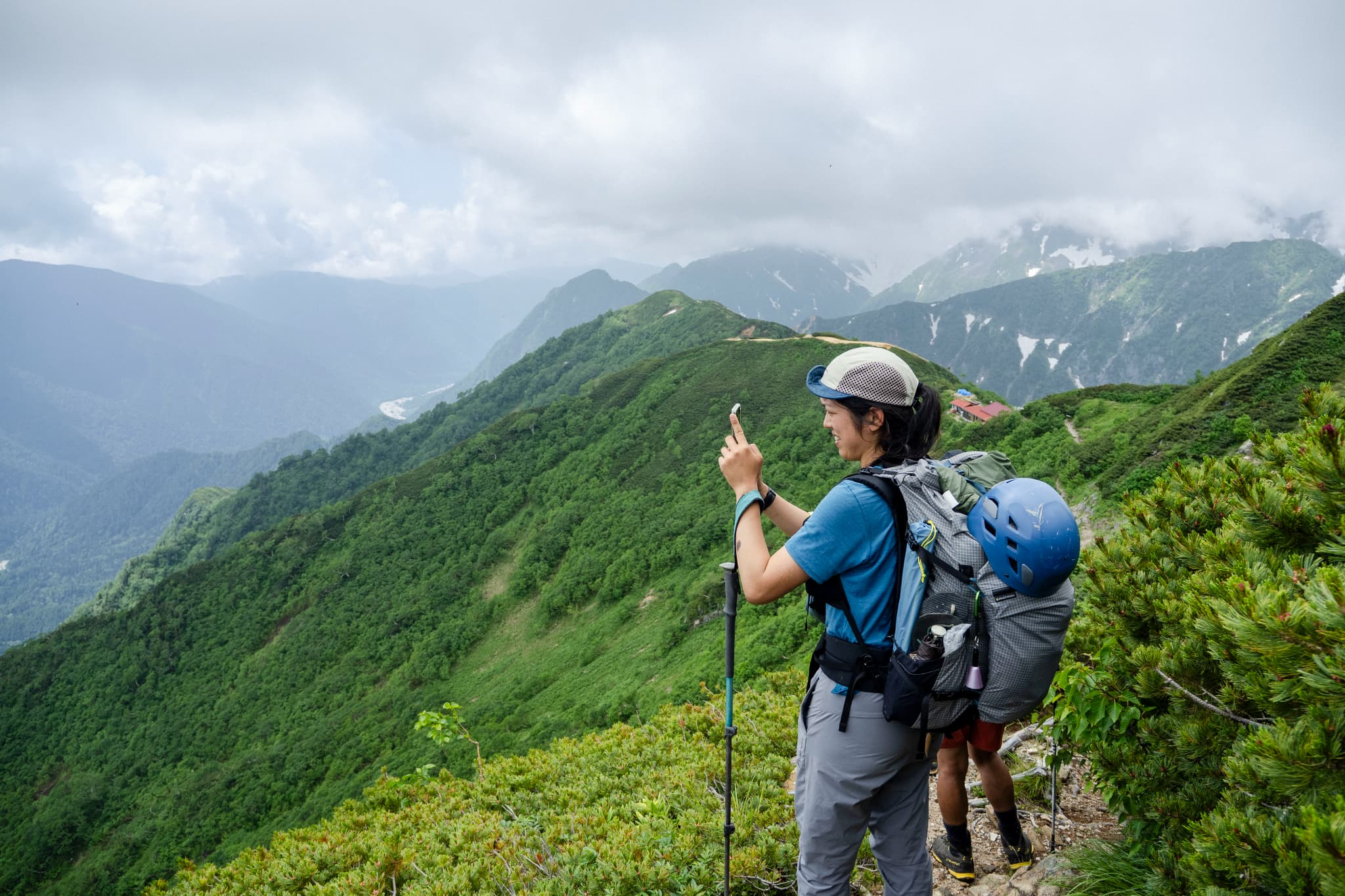
Shohoko’s Voice
Disaster! The photographer laughed, “There’s a hole in your rear!” I’d ripped a thumb-size hole sitting on rock—on brand-new pants! Tape from my MY FIRST AID kit patched it, but I wished I’d packed sewing gear. (Sorry, Knorr, for the tape!)
Next came the rocky Higashi-Kama ridge—a mix of excitement and worry the hole would grow. Long distance, ups and downs, nutrition, water, tricky footing, weather… plenty to juggle—no more problems, please, hole don’t widen!
From Ōtenjō we dropped steeply, then traversed toward Mt. Nishi. Beyond lies the Higashi-Kama ridge, a helmet-recommended, lengthy stretch; foot traffic thins beyond this point and the mountains grow wilder.
Stay tuned for Part 2, where we tackle the hardest section—the Higashi-Kama ridge—and summit Mt. Yari. Don’t miss it!
